New Zealand is home to a variety of unique and fascinating bird species, many of which are endemic to the country. From the iconic Kiwi to the cheeky Kea, New Zealand’s birds are found nowhere else in the world and are a source of wonder and fascination for birdwatchers and nature enthusiasts alike.
With their unique plumage, behaviors and habitats, New Zealand’s birds offer a unique insight into the country’s unique ecology, and are a source of pride for all New Zealanders.
1. Kiwi
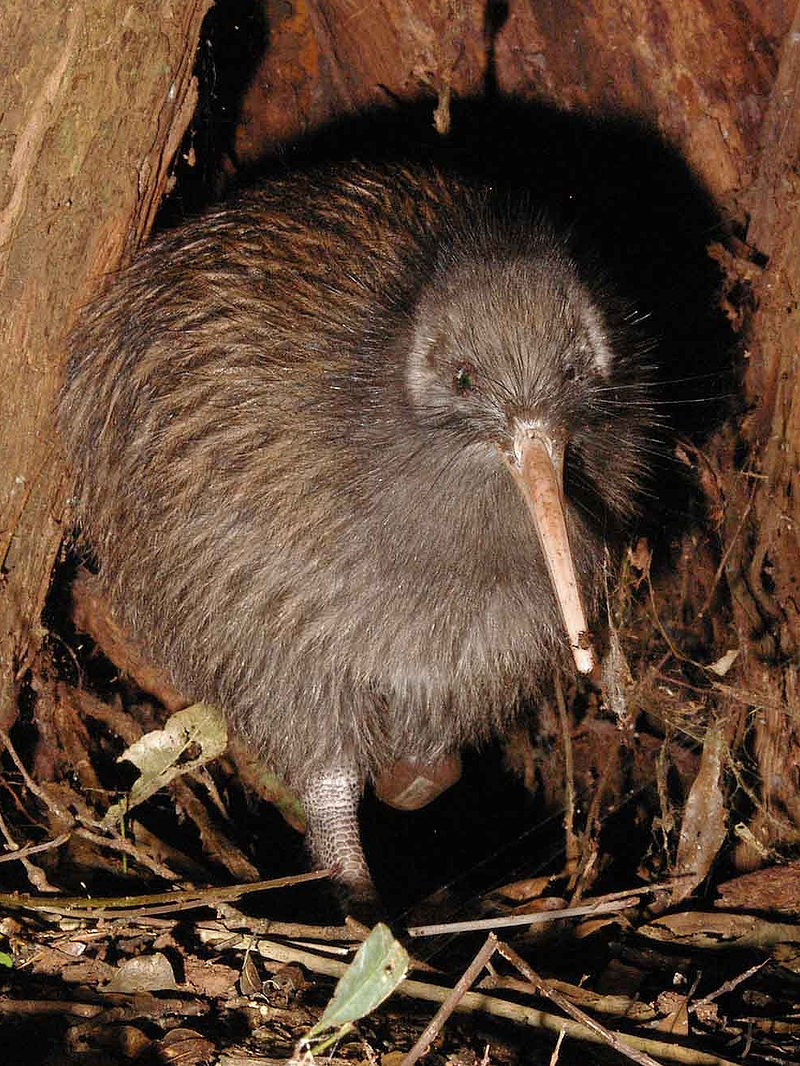
Kiwi are a unique species of flightless birds endemic to New Zealand. With their small stature and size, they are the smallest living ratites—a group which also includes ostriches, emus, rheas and cassowaries.
They have long beaks with nostrils at the tip; brown furry feathers instead of scales; strong legs for digging through soil in search for food like worms and insects; no tail or wings; and sharp claws used for defense against predators such as cats or stoats.
Kiwis live an average life span of 20-30 years in the wild. It is truly amazing how this little bird has adapted so well to its environment despite being without wings – it just goes to show that even if you don’t fly high above the clouds, you can still reach great heights on land.Scientific classification:
| Kingdom | Animalia |
| Phylum | Chordata |
| Class | Aves |
| Infraclass | Palaeognathae |
| Clade | Novaeratitae |
| Order | Apterygiformes Haeckel, 1866 |
| Family | Apterygidae Gray, 1840[1] |
| Genus | Apteryx Shaw, 1813[1] |
Also Featured In: Birds You’ll Find in Night, Endangered Birds of New Zealand
2. Kākāpō
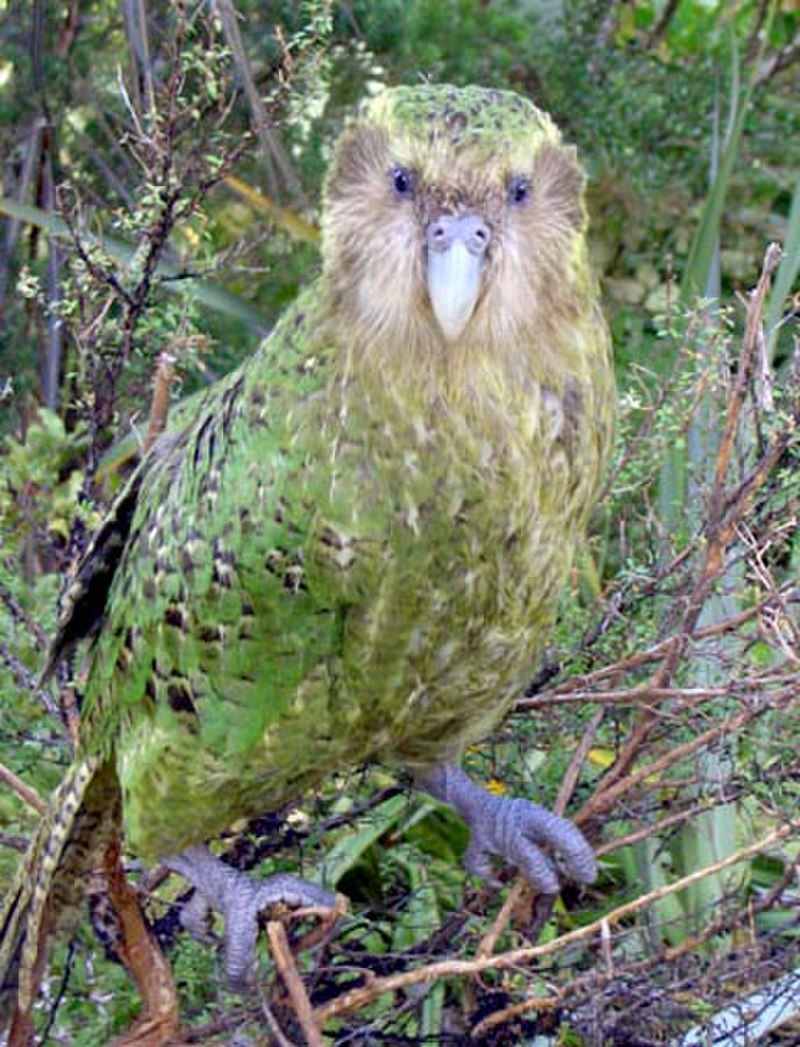
Kākāpō are unique and endangered birds native to New Zealand. They grow up to 25 inches in length, with finely-blotched yellow-green plumage and a distinct facial disc made of feathers.
These flightless parrots have nocturnal habits, spending the night time on the ground foraging for food like berries or insects.
Kākāpōs were once widespread across both main islands but their population has been dramatically reduced due to deforestation, predation by introduced species such as cats and rats, and competition from other bird species.
Today there are only about 200 kakapo left in existence making it one of the world’s rarest birds – conservation efforts must be increased if we want these amazing animals around for future generations.Scientific classification:
| Kingdom | Animalia |
| Phylum | Chordata |
| Class | Aves |
| Order | Psittaciformes |
| Superfamily | Strigopoidea |
| Family | Strigopidae Bonaparte, 1849 |
| Genus | Strigops G.R. Gray, 1845 |
| Species | S. habroptilus |
Also Featured In: Most Common Birds in Oceania,
3. Takahe
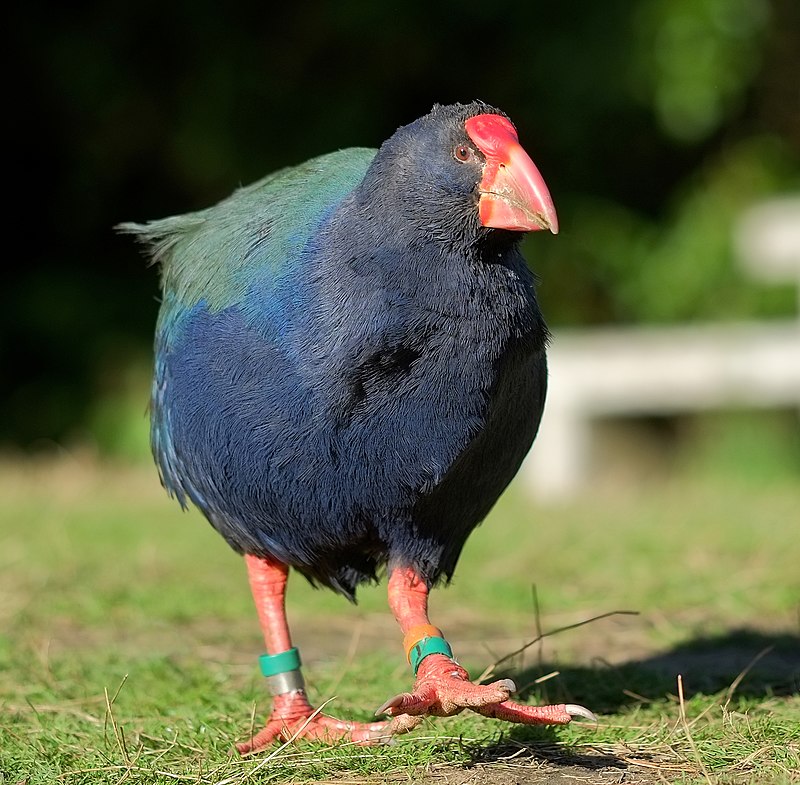
The South Island takahē is a flightless bird that belongs to the rail family. It is native to New Zealand and was hunted extensively by Māori for centuries prior to being named and described by Europeans.
The species stands out from its relatives due to its large size, earning it the nickname “the giant of all rails”.
Takahe are mostly green in colour with purple-blue chests and black stripes running along their heads, wings, back and tail feathers.
Their diet consists mainly of grasses but they also enjoy aquatic plants such as ferns or wild celery stems found around lakeshores or wetlands.
This habitat provides them with shelter as well as food sources necessary for survival throughout winter months when other foods may become scarce.
They usually inhabit places between 1,000m above sea level up until 3,000m where temperatures tend be cooler than lower levels during summer periods which makes surviving easier.Scientific classification:
| Kingdom | Animalia |
| Phylum | Chordata |
| Class | Aves |
| Order | Gruiformes |
| Family | Rallidae |
| Genus | Porphyrio |
| Species | P. hochstetteri |
Also Featured In: Black Birds in New Zealand,
4. Moa
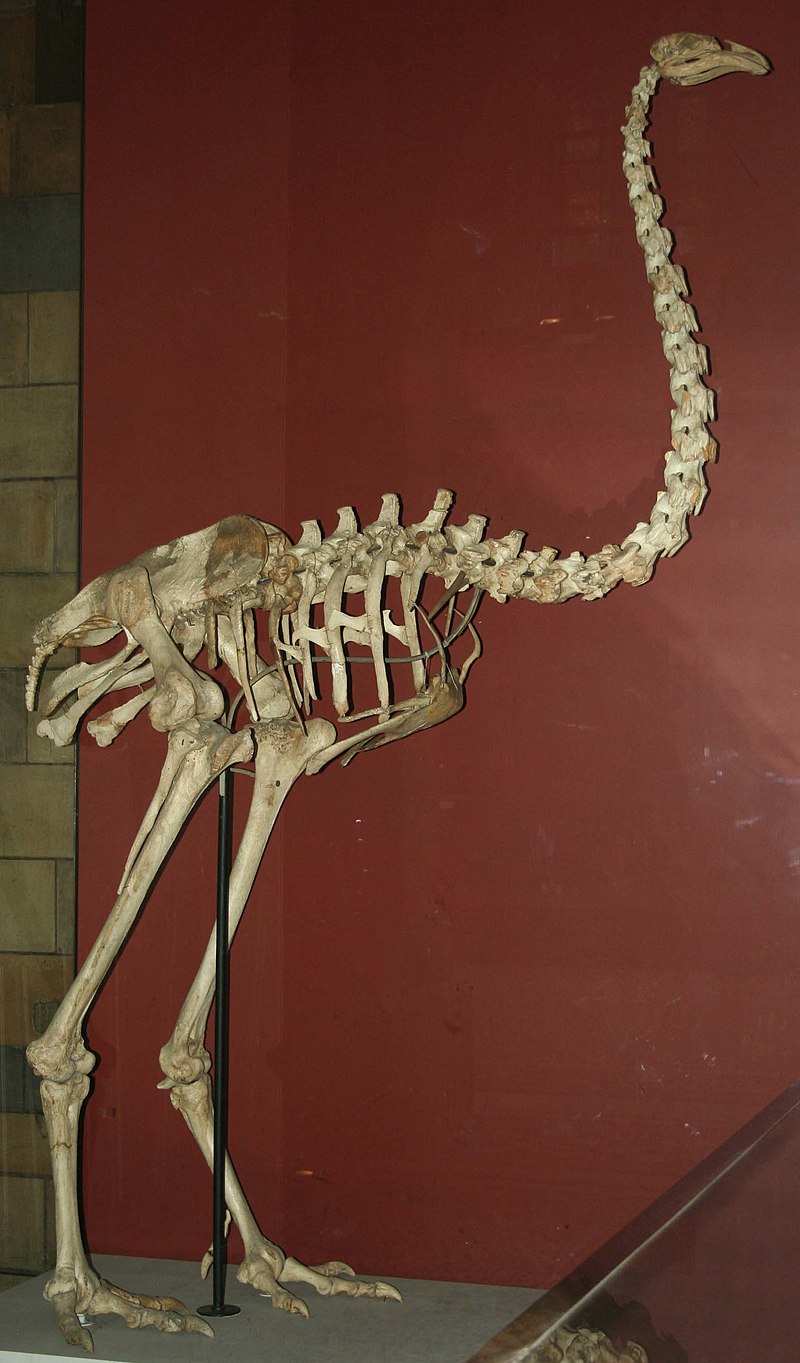
Moa were a group of flightless birds that lived in New Zealand until extinction. There were nine species spread over six genera, with the two largest species reaching heights up to 3.6 meters and weighing 230kg.
The smallest moa was only about 0.9m tall and weighed around 5kg – this being the bush moa (Anomalopteryx didiformis).
Moas had no natural predators as they evolved before humans arrived on their islands, leading to their eventual demise when humans began hunting them for food or sport.
Although these birds are now long gone, we can still appreciate their unique features that once made them an important part of the ecology of New Zealand’s native wildlife.Scientific classification:
| Kingdom | Animalia |
| Phylum | Chordata |
| Class | Aves |
| Infraclass | Palaeognathae |
| Clade | Notopalaeognathae |
| Order | †Dinornithiformes Bonaparte, 1853[1] |
5. Kea
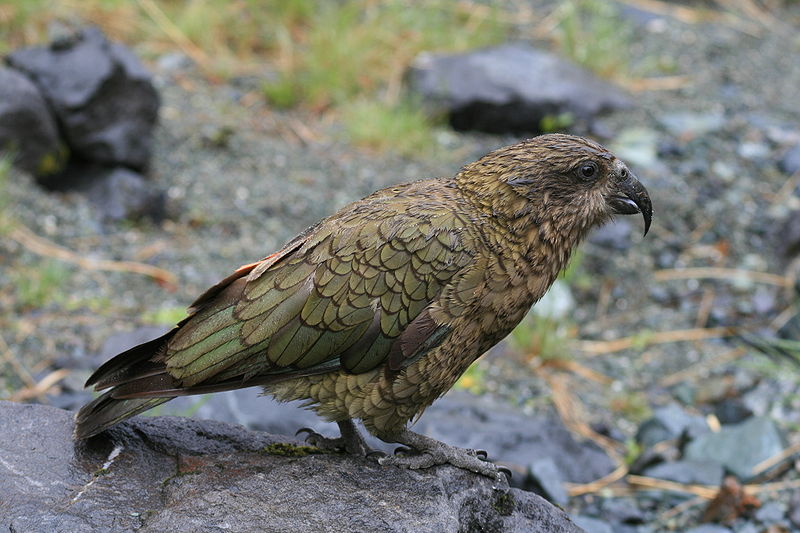
The Kea is an impressive species of large parrot found in the South Island of New Zealand. It stands at 48 cm and has a beautiful olive-green colour with orange under its wings, as well as a long curved grey-brown upper beak.
Its diet consists mainly of root vegetables but also includes carrion on occasion.
The Kea is known for being one of the world’s few alpine parrots, living in forests only below 1,200m above sea level due to its tolerance towards cold weather conditions.
It’s incredibly intelligent too; they have been observed solving puzzles and using tools. This remarkable bird makes a great addition to any nature enthusiast’s list when visiting this region .Scientific classification:
| Kingdom | Animalia |
| Phylum | Chordata |
| Class | Aves |
| Order | Psittaciformes |
| Family | Strigopidae |
| Genus | Nestor |
| Species | N. notabilis |
6. Kākā
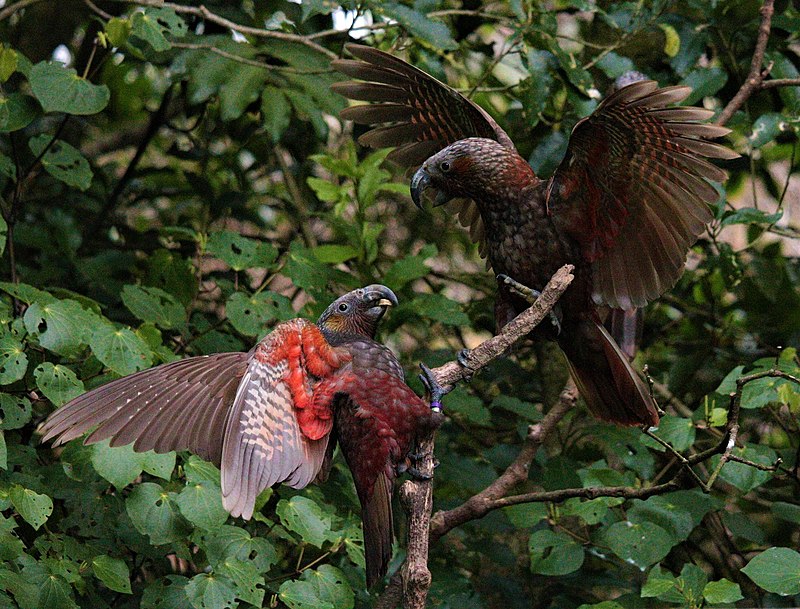
Kākā is a large parrot belonging to the Nestoridae family, and found only in New Zealand’s native forests.
It has two subspecies and is endangered due to its disappearing range; most of its former habitats have been lost.
The conservation efforts are underway with re-introduction attempts taking place on offshore islands.
Kākās live in tree cavities where they feed mostly on fruits, seeds, flowers, leaves as well as insects and larvae.
They form flocks during breeding season which often consist of adult birds alongwith fledglings from previous years that help raise new chicks – the social nature of this species makes it very endearing.Scientific classification:
| Kingdom | Animalia |
| Phylum | Chordata |
| Class | Aves |
| Order | Psittaciformes |
| Family | Strigopidae |
| Genus | Nestor |
| Species | N. meridionalis |
Also Featured In: Most Common Birds in Stewart Island,
7. Weka
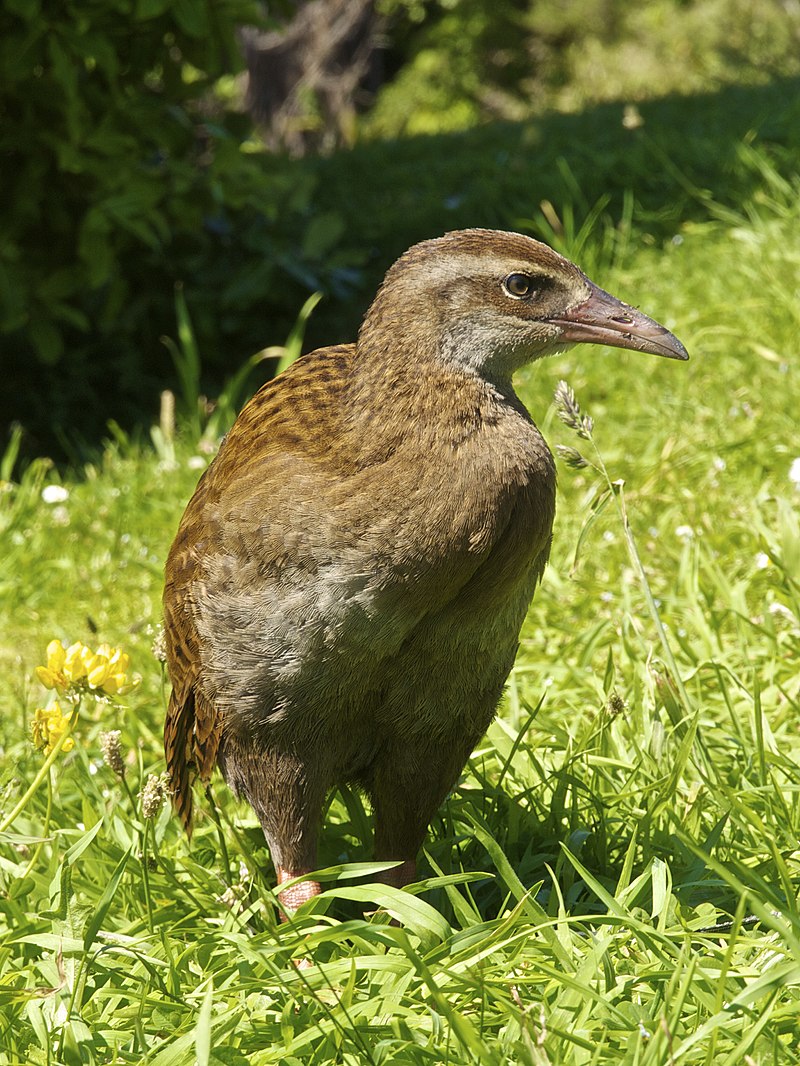
The Weka bird is a flightless species of the Rail family, endemic to New Zealand. It has four subspecies although only two are supported genetically.
The Weka is around the size of a chicken and its body colouring can range from dark brown to reddish-brown.
They feed on both plants and animals as they are omnivores, consuming fruits, roots, invertebrates such as worms or insects and small vertebrates like lizards.
These birds have strong legs which allow them to easily run through vegetation in search for food but also make them difficult prey for predators due to their agility when escaping danger.
Additionally their wings provide protection against cold weather by covering their heads while sleeping; making it an impressive yet adorable creature.Scientific classification:
| Kingdom | Animalia |
| Phylum | Chordata |
| Class | Aves |
| Order | Gruiformes |
| Family | Rallidae |
| Genus | Gallirallus |
| Species | G. australis |
8. Morepork
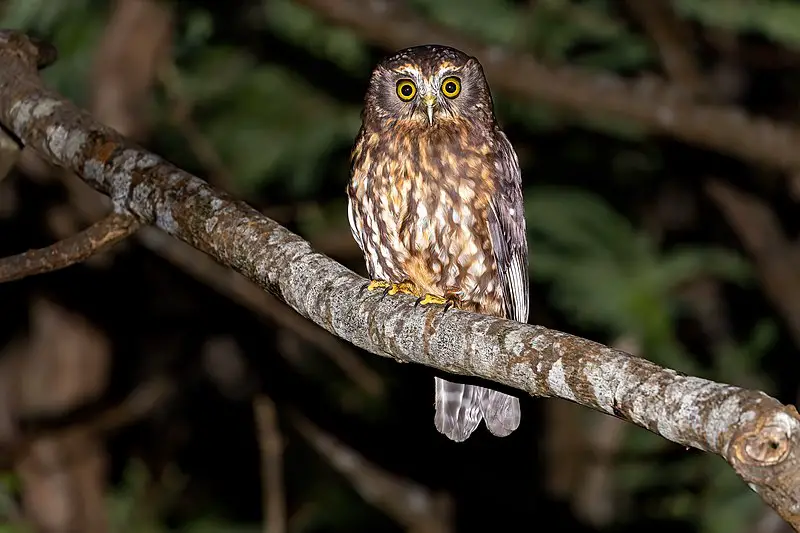
Morepork is a small brown owl found in New Zealand, Norfolk Island and formerly Lord Howe Island. It has almost 20 alternative common names like mopoke and boobook which are onomatopoeic, imitating its distinctive two-pitched call.
There are three subspecies of moreporks: one that is extinct and two still surviving today.
This species usually lives within native forests or near pine plantations for shelter during the day; they hunt at night using their excellent hearing to detect prey such as mice, rats and insects moving through vegetation or along the ground surface.
They have also been known to take birds up to the size of thrushes from bird tables.
Moreporks play an important role in maintaining ecological balance by controlling populations of rodents and other pests.Scientific classification:
| Kingdom | Animalia |
| Phylum | Chordata |
| Class | Aves |
| Order | Strigiformes |
| Family | Strigidae |
| Genus | Ninox |
| Species | N. novaeseelandiae |
9. New Zealand Fantail
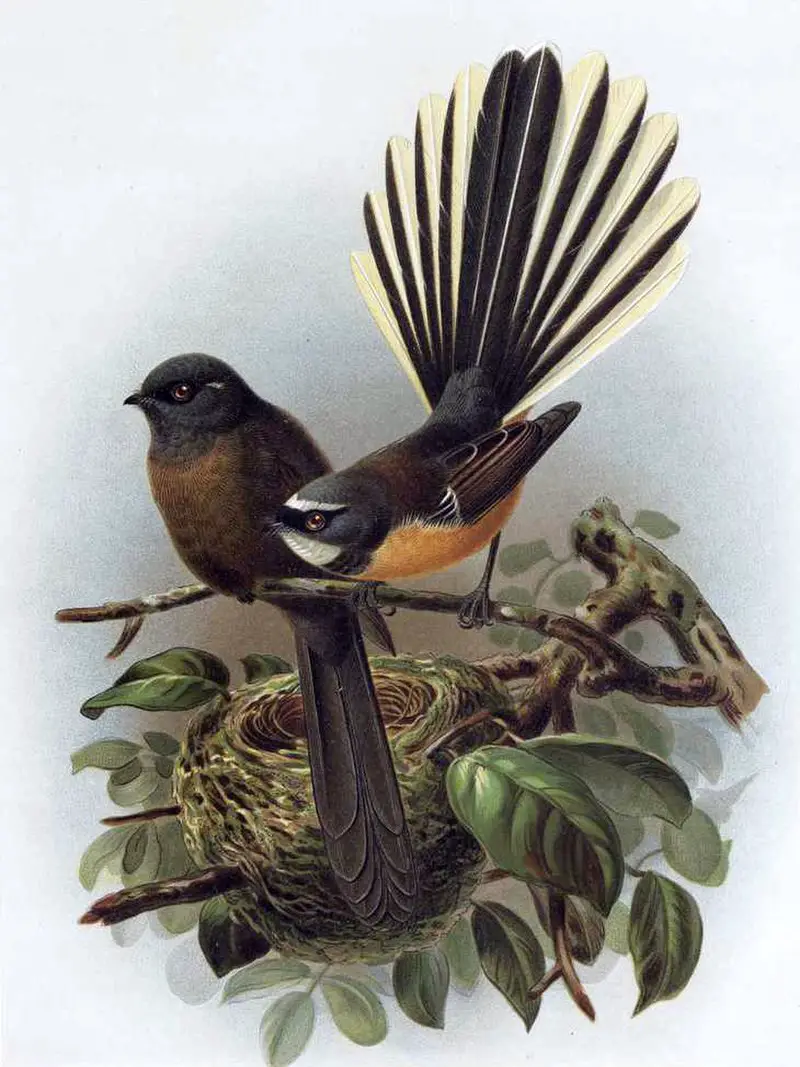
The New Zealand fantail, or Rhipidura fuliginosa, is a small insectivorous bird found only in New Zealand. It has four subspecies which can be identified by their distinctive coloring and range: the South Island’s R.
f. fuliginosa; North Island’s R. f. placabilis; Chatham Islands’ R.f penita; and Lord Howe Islands extincted species of R.. f cervina.
These birds are affectionately known to Maoris as piwakawaka, tiwakawaka or piwaiwaka due to their beautiful flycatcher-like behavior.
With black upperparts and white underbelly feathers they have long tail feathers that sweep from side to side while searching for food – making them an iconic part of New Zealands native wildlife sceneScientific classification:
| Kingdom | Animalia |
| Phylum | Chordata |
| Class | Aves |
| Order | Passeriformes |
| Family | Rhipiduridae |
| Genus | Rhipidura |
| Species | R. fuliginosa |
10. Tomtit
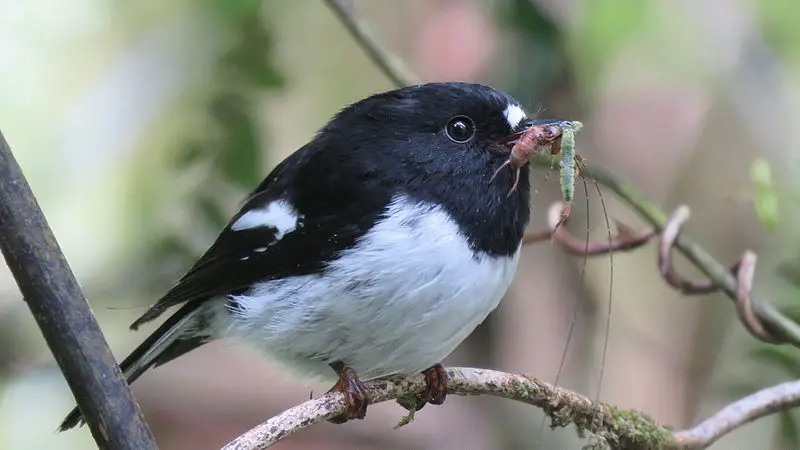
The Tomtit is a small bird native to New Zealand. With its white chin and brown head, it stands out among the green foliage of its habitat.
It has several names in Māori, including miromiro for the North Island variety and ngirungiru for the South Island one.
This species can be found across both main islands as well as some of their outliers, making them quite common throughout New Zealand’s landscape.
The Tomtit feeds on insects they find while searching through leaf litter on forest floors or flitting around shrubs in search of food sources like caterpillars or spiders.
These birds are bold enough to come close to humans but remain wary when approached too closely; however, they still provide an enjoyable sight with their bright colours and cheerful song.Scientific classification:
| Kingdom | Animalia |
| Phylum | Chordata |
| Class | Aves |
| Order | Passeriformes |
| Family | Petroicidae |
| Genus | Petroica |
| Species | P. macrocephala |
11. Silvereye
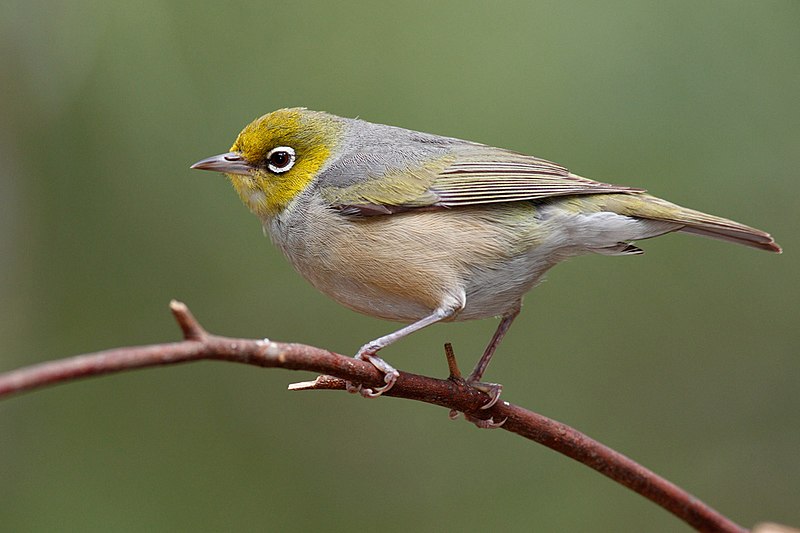
The silvereye, also known as wax-eye, is a tiny passerine bird native to the south-west Pacific region. It was first recorded in New Zealand in 1832 and there were greater numbers by 1856.
These birds are omnivorous feeders that make their home in open woodlands or gardens with lush vegetation.
Their plumage has greyish tones on top of its head and wings giving it a silver sheen look which inspired its common name ‘silvereye’.
The underside of these birds have white feathers allowing for camouflage among foliage when they fly low over shrubs and trees seeking food such as nectar, insects and fruit.
They are social creatures who often flock together to share meals while communicating through their unique chirps.Scientific classification:
| Kingdom | Animalia |
| Phylum | Chordata |
| Class | Aves |
| Order | Passeriformes |
| Family | Zosteropidae |
| Genus | Zosterops |
| Species | Z. lateralis |
Also Featured In: Birds that Live around Brisbane, Silver Birds You Should Know
12. South Island Robin
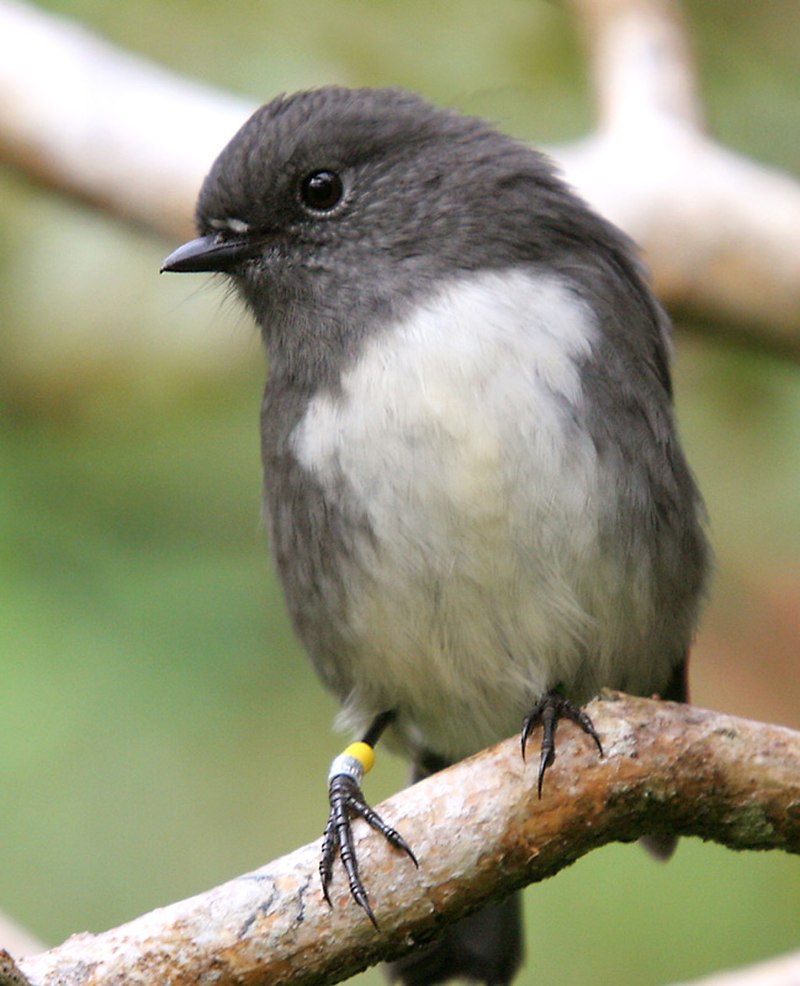
The South Island robin is a sparrow-sized bird native to New Zealand, and it has the status of an officially protected species. This species is sparsely distributed across the South Island and Stewart Island/Rakiura.
It belongs to two subspecies: The nominate (Petroica australis) and P. australis rakiura from Stewart Island respectively.
Both types have reddish brown plumage with a white lower belly, dark grey cheeks, black wings with white tips as well as yellow eyes and legs.
They are omnivores that feed on insects such as moths or caterpillars in addition to fruits like berries or seeds when available.
Breeding season takes place mainly during summer months – around October through April – where they can produce up to three broods per year.
These birds make their nests in tree cavities which helps them keep safe from potential predators while also providing shelter for both eggs & chicks until fledging occurs after roughly 16 days post hatching.Scientific classification:
| Kingdom | Animalia |
| Phylum | Chordata |
| Class | Aves |
| Order | Passeriformes |
| Family | Petroicidae |
| Genus | Petroica |
| Species | P. australis |
13. Grey Warbler
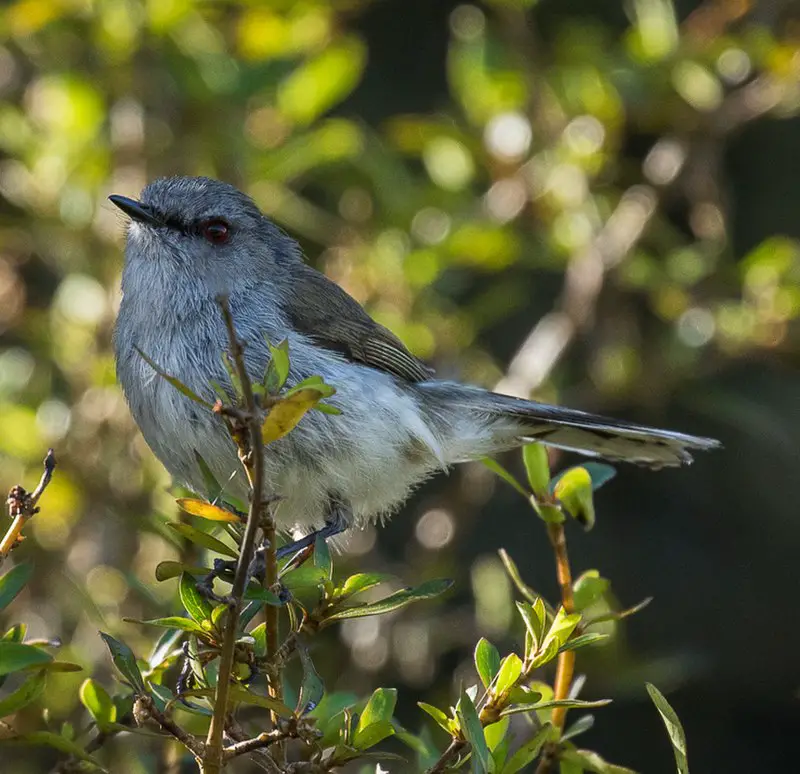
The Grey Warbler (Gerygone igata), also known by its Māori name Riroriro, is a small insectivorous bird native to New Zealand. It lives mainly in temperate forests and has been given many names such as Teetotum or Rainbird.
At only 11 centimeters long and weighing next to nothing, the Grey Warbler can often be spotted flitting about among trees for insects on which it feeds.
Its plumage consists of shades of brownish-grey with yellow spots around the face and back of head; this gives them perfect camouflage when hidden amongst foliage.
The male of the species has an especially melodious song that adds charm to our NZ woodland areas – if you’re lucky enough to hear one singing then take pause: You are listening to a true Kiwi icon.Scientific classification:
| Kingdom | Animalia |
| Phylum | Chordata |
| Class | Aves |
| Order | Passeriformes |
| Family | Acanthizidae |
| Genus | Gerygone |
| Species | G. igata |
14. Albatrosses
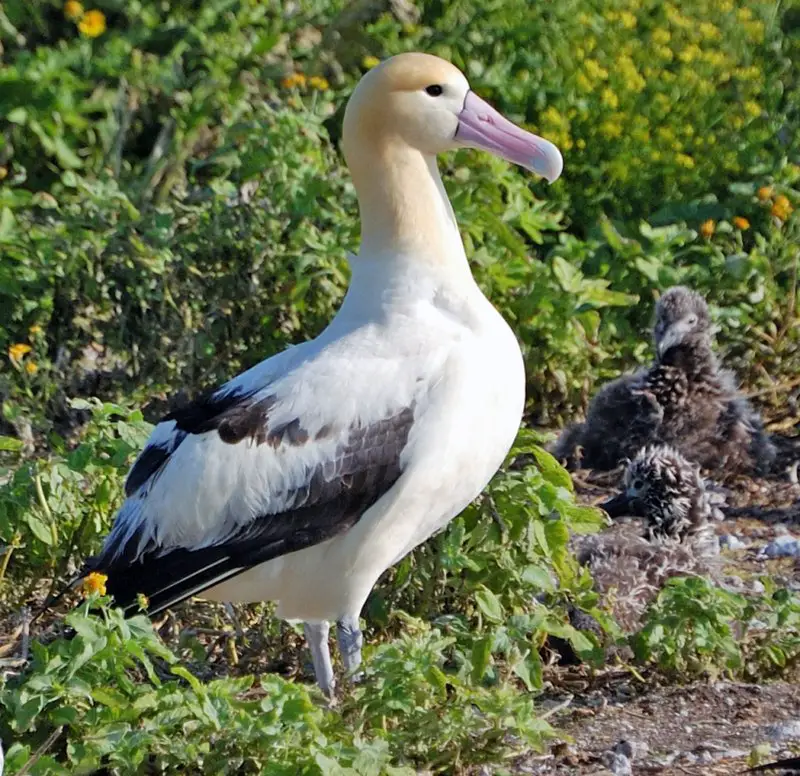
Albatrosses are majestic, large seabirds belonging to the Diomedeidae family in the Procellariiformes order.
These birds have an impressive wingspan and can fly great distances over oceans with minimal effort.
They inhabit all of the world’s southern oceans, ranging from Antarctica up through New Zealand and Australia as well as parts of the northern Pacific Ocean region.
Albatross populations were once abundant throughout much of their range but they now face threats such as longline fishing gear entanglement which has caused a significant decline in numbers in some areas.
Furthermore, occasional vagrants have been found outside their native ranges including fossil remains suggesting that albatrosses previously existed on other regions too.Scientific classification:
| Kingdom | Animalia |
| Phylum | Chordata |
| Class | Aves |
| Order | Procellariiformes |
| Family | Diomedeidae G.R. Gray 1840[1] |
Also Featured In: Birds You’ll Find in the Sea, Birds that Live in the Ocean
15. Songbirds
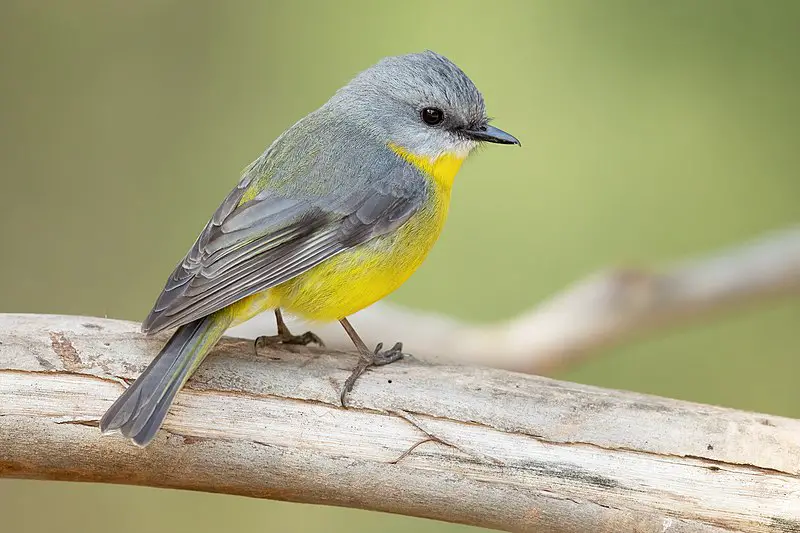
Songbirds are a special suborder of perching birds found all over the world. These beautiful creatures have intricate vocal organs that allow them to produce elaborate bird songs, making them stand out from other species.
With around 5,000 different types of songbird in existence, they come in various sizes and colors with complex feathers adding to their beauty.
Songbirds play an important role in eco-systems as they help disperse seeds by eating fruit and insects which act as agents for pollination.
Their presence also serves to attract more biodiversity into areas where these delicate animals live, creating vibrant habitats full of life.Scientific classification:
| Kingdom | Animalia |
| Phylum | Chordata |
| Class | Aves |
| Order | Passeriformes |
| Clade | Eupasseres |
| Suborder | Passeri Linnaeus, 1758 |
16. Yellow-Eyed Penguin
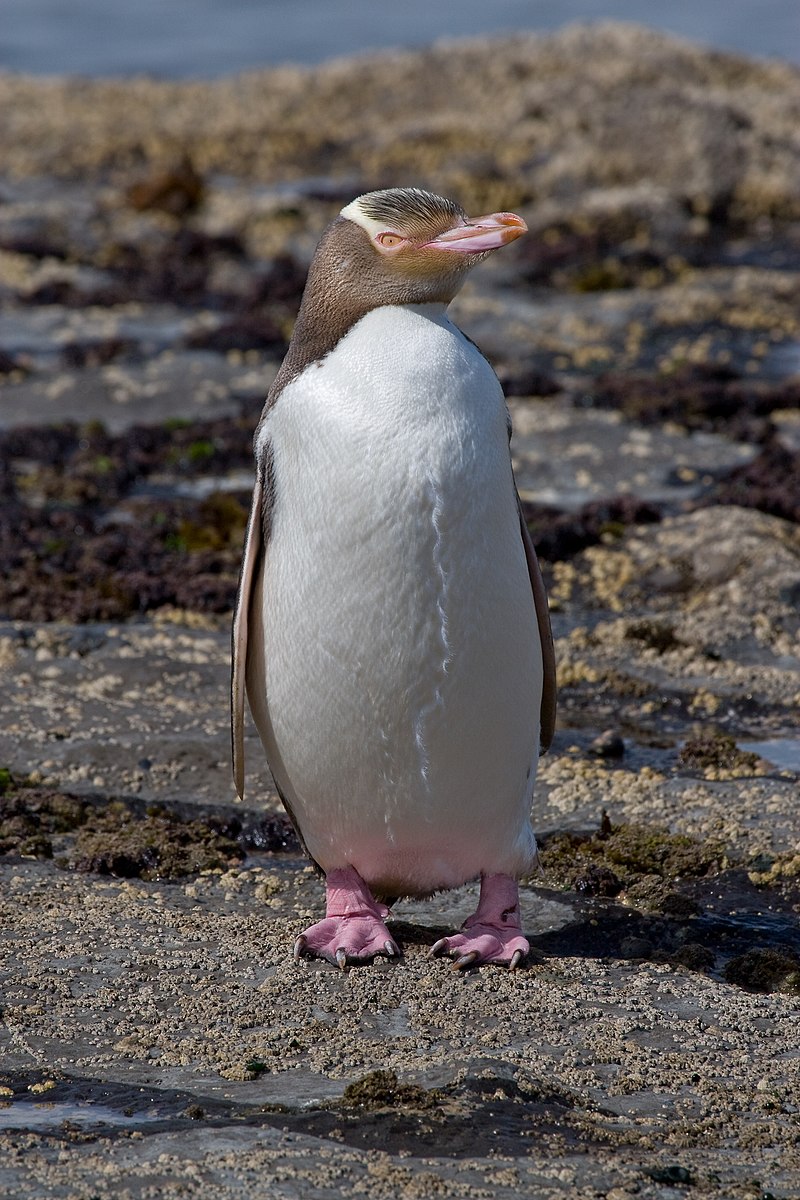
The Yellow-eyed Penguin, also known as hoiho or tarakaka, is a species of penguin endemic to New Zealand.
It can be distinguished from other penguins by its yellow eyes and distinctive yellow band across the top of its head.
Molecular research has revealed that it is closely related to Eudyptes Penguins rather than the Little Penguin.
As with most penguins, the Yellow-eyed Penguin’s diet consists mainly of fish which it catches in shallow waters near shorelines.
During breeding season they form colonies on rocky coasts around New Zealand where they build nests out of pebbles and twigs lined with feathers for their eggs and chicks.
With such an iconic presence in New Zealand’s waters, these charming birds are sure to make any beach trip memorable.Scientific classification:
| Kingdom | Animalia |
| Phylum | Chordata |
| Class | Aves |
| Order | Sphenisciformes |
| Family | Spheniscidae |
| Genus | Megadyptes |
| Species | M. antipodes |
Also Featured In: Tundra Birds,
17. Red-Crowned Parakeet
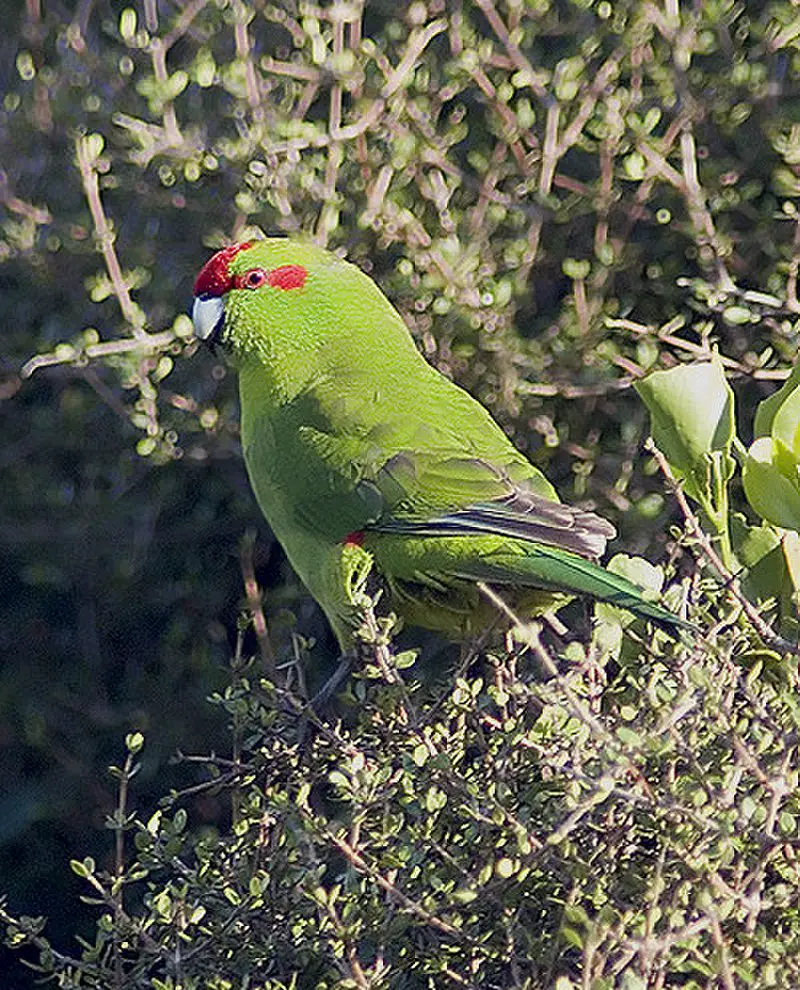
The Red-crowned Parakeet is a beautiful and vibrant small parrot native to New Zealand. It has bright green plumage, with the distinctive red pattern on its head giving it the name ‘red-fronted’.
These birds are versatile in their diets and can be found in many different habitats, making them an interesting species for birdwatchers.
Unfortunately, these birds were once classified as near threatened due to predation from invasive predators such as cats and rats.
Conservation efforts have been made since then however which has seen populations increase again throughout New Zealand’s national parks and reserves.
They make great companions too – they love interacting with people.Scientific classification:
| Kingdom | Animalia |
| Phylum | Chordata |
| Class | Aves |
| Order | Psittaciformes |
| Family | Psittaculidae |
| Genus | Cyanoramphus |
| Species | C. novaezelandiae |
18. Yellowhead
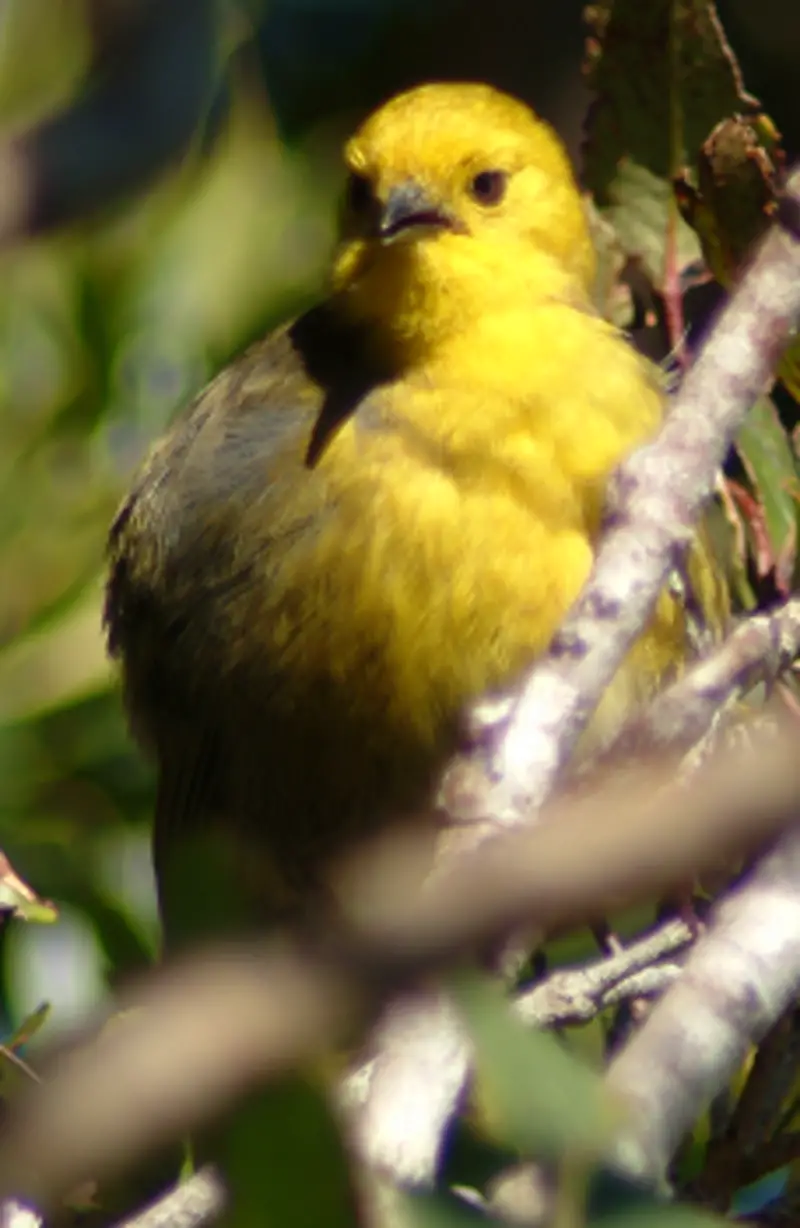
The Yellowhead is a small and adorable bird found in the South Island of New Zealand. It has a distinctive yellow head, which gives it its name.
This little passerine was once very common in the forests but unfortunately after the introduction of rats and stoats, their numbers declined drastically making them near threatened today.
The 19th century people called this species “bush canary” due to its trilling song that could be heard everywhere when they were abundant.
In Māori language, it is known as mōhua or Mohoua ochrocephala – an elegant way to refer to this beautiful creature.Scientific classification:
| Kingdom | Animalia |
| Phylum | Chordata |
| Class | Aves |
| Order | Passeriformes |
| Family | Mohouidae |
| Genus | Mohoua |
| Species | M. ochrocephala |
19. Blue Duck
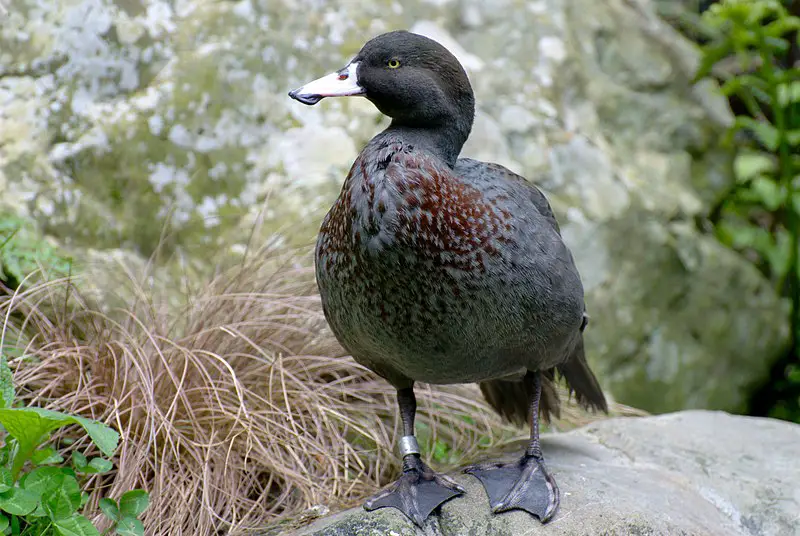
The Blue Duck, also known as the Whio, is a species of waterfowl found only in New Zealand. It belongs to the Anatidae family, which includes ducks and geese.
They are most closely related to dabbling ducks from the tribe Anatini. This unique bird can be identified by its striking blue plumage and orange-red bill with white patches at the base.
The Whio has been featured on New Zealand’s $10 banknote since 2015 due to its status as an endangered species – there are currently only around 3000 left in existence.
Despite this alarming population decline, conservation efforts have resulted in a steady increase over recent years thanks largely to pest control programmes and habitat restoration initiatives.
With continued support for these measures, hopefully one day we will see more of these incredible birds throughout their natural range once again.Scientific classification:
| Kingdom | Animalia |
| Phylum | Chordata |
| Class | Aves |
| Order | Anseriformes |
| Family | Anatidae |
| Genus | Hymenolaimus G.R. Gray, 1843 |
| Species | H. malacorhynchos |
20. Haast’s Eagle
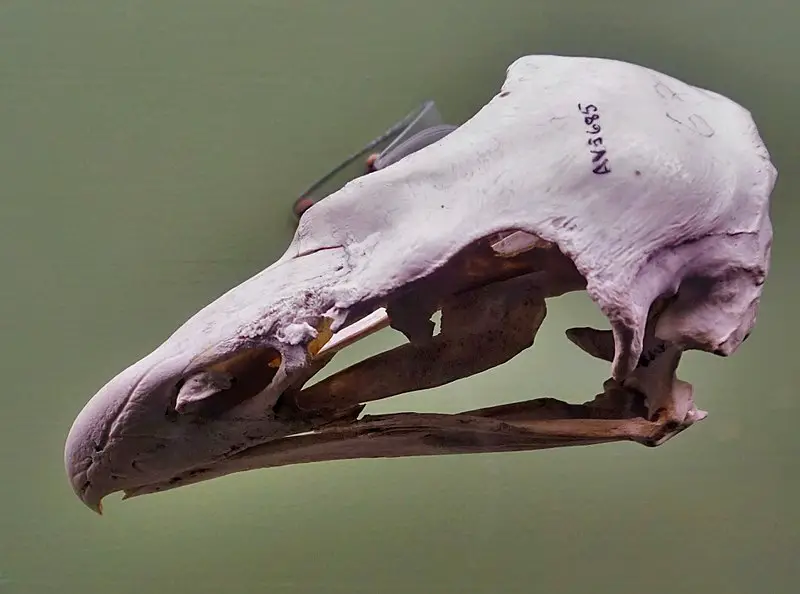
Haast’s eagle was a large and powerful bird of prey that once lived in the South Island of New Zealand. It is believed to be the pouakai from Māori legend, which makes it even more special.
The Haast’s eagle had an estimated weight of 15 kilograms (33 lb), making it one of the largest eagles known to exist – much larger than its cousin, the harpy eagle at 9 kg (20 lb).
This impressive size can likely be attributed to its diet; since their primary food source were moas , they evolved over time in order to better hunt these giant birds.
Unfortunately this species went extinct around 1400 A.D., due mostly likely ot deforestation and human hunting practices within New Zealand during that period.
Despite this sad end, however, Haast’s Eagle will always remain as a reminder of how majestic our environment can truly become when protected properly.Scientific classification:
| Kingdom | Animalia |
| Phylum | Chordata |
| Class | Aves |
| Order | Accipitriformes |
| Family | Accipitridae |
| Genus | Hieraaetus |
| Species | †H. moorei |
21. South Island Saddleback
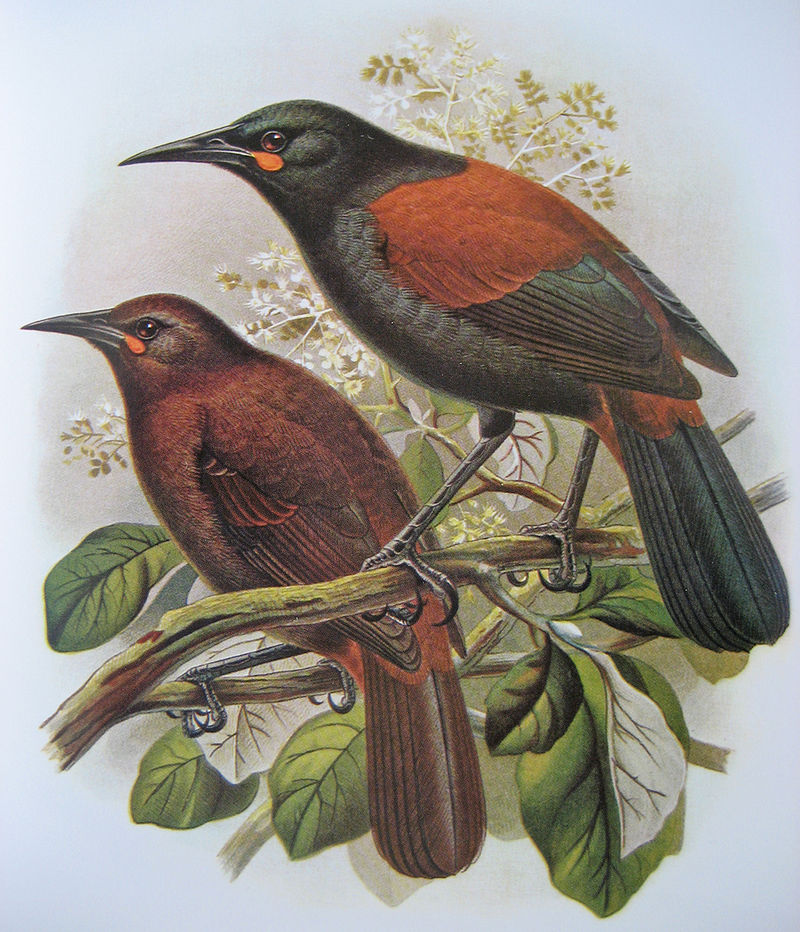
The South Island saddleback, or tīeke, is an endangered bird from New Zealand’s wattlebird family.
It is endemic to the South Island of New Zealand and was once considered part of the same species as its North Island counterpart.
The Department of Conservation currently lists it as At Risk–Declining due to habitat destruction that began in the early 19th century when settlers cleared forests for farming and other uses.
To help protect this rare species, conservation efforts have included captive breeding programs and restoring native bush habitats on predator-free islands.
As a result, populations are slowly increasing but much more needs to be done to ensure their long-term survival in the wild.Scientific classification:
| Kingdom | Animalia |
| Phylum | Chordata |
| Class | Aves |
| Order | Passeriformes |
| Family | Callaeidae |
| Genus | Philesturnus |
| Species | P. carunculatus |
22. Great Crested Grebe
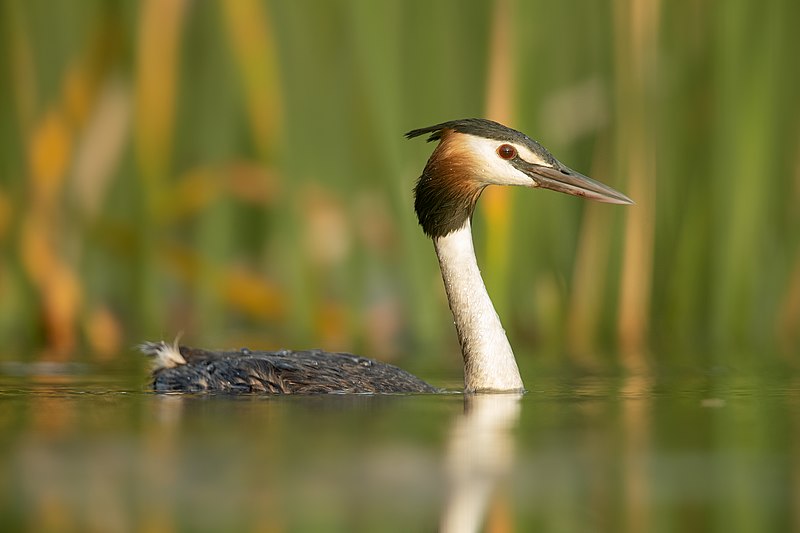
The great crested grebe is a beautiful water bird belonging to the grebe family. It is easily identified by its striking head crest, which it displays during mating rituals.
Originally classified in 1758 by Carl Linnaeus as Colymbus cristatus, this species has since become the type example for all other members of its genus Podiceps.
Great crested grebes are known for their intricate courtship behavior such as synchronized swimming and “head-shaking” motions used to attract mates.
They also possess unique features like red eyes and lobed feet that help them swim efficiently underwater when hunting for food.
The great crested grebe can be found throughout much of Europe, Asia, Africa and Australasia where they inhabit freshwater wetlands or shallow lakeshores with plenty of vegetation nearby to hide from predators while nestingScientific classification:
| Kingdom | Animalia |
| Phylum | Chordata |
| Class | Aves |
| Order | Podicipediformes |
| Family | Podicipedidae |
| Genus | Podiceps |
| Species | P. cristatus |
23. Fantails
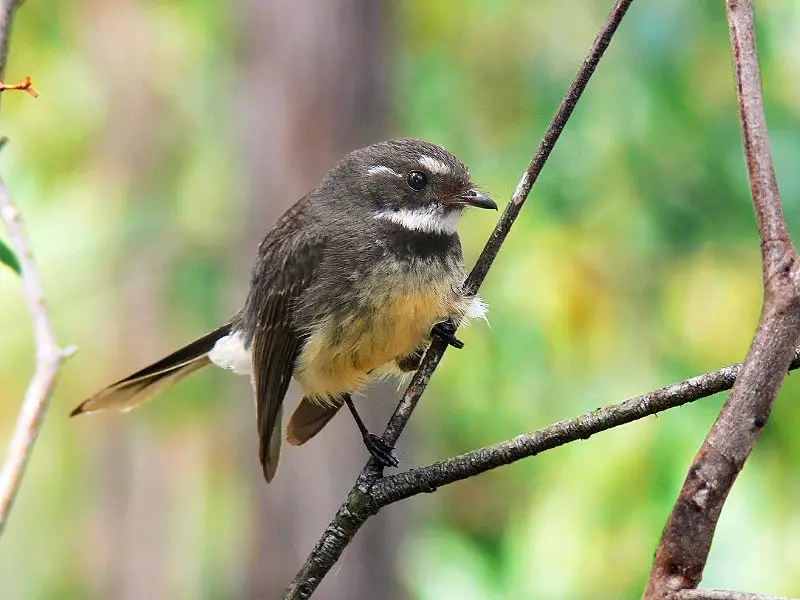
Fantails are small insectivorous birds found in Australasia, Southeast Asia and India. They measure between 15-18cm long and hunt insects on the wing with expert precision.
Their name comes from their fan-shaped tail which they use to balance while chasing after prey or maneuvering through dense vegetation.
As well as a compact size, fantails have distinctive black eyes surrounded by white eyebrows that contrast against its grey back feathers – making them easy to identify.
These friendly creatures often approach humans when looking for food or may even follow people around like an attentive pet.
All in all, fantail birds are a delight of nature that bring much joy with their cheerful presence.Scientific classification:
| Kingdom | Animalia |
| Phylum | Chordata |
| Class | Aves |
| Order | Passeriformes |
| Family | Rhipiduridae |
| Subfamily | Rhipidurinae |
| Genus | Rhipidura Vigors & Horsfield, 1827 |
24. Westland Petrel
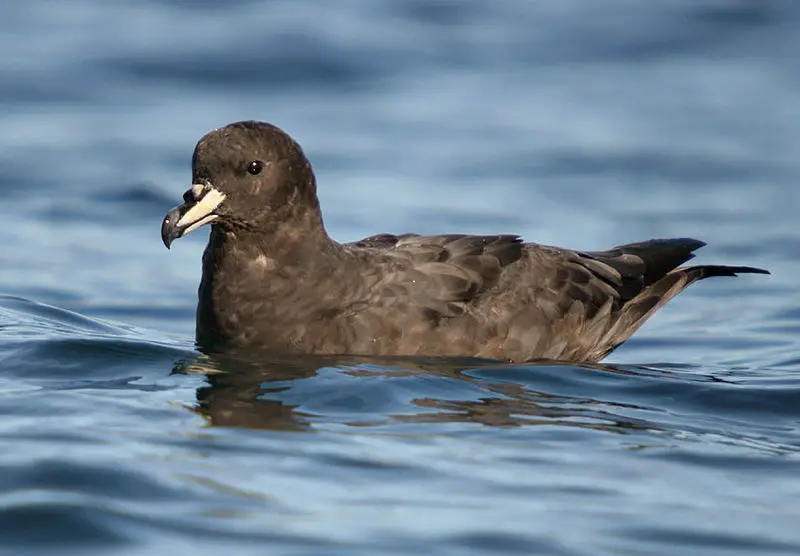
The Westland petrel is an endemic species to New Zealand, belonging to the Procellariidae family of seabirds. It has a stocky build and weighs around 1,100 grams (39 oz), making it one of the largest burrowing petrels.
Its dark blackish-brown feathers are complemented by its distinctively black bill and feet.
It breeds on islands off both coasts of South Island in summertime before migrating northwards for winter feeding grounds further offshore away from land.
The species feeds mainly on squid but also takes small fish such as herring or pilchard when available close enough to shorelines where they breed.
They feed at night using their sense of smell combined with sonar like clicks produced from their bills which helps them locate food beneath surface waters many meters deep underwater during darkness hours only illuminated by moonlight reflections upon waves above .Scientific classification:
| Kingdom | Animalia |
| Phylum | Chordata |
| Class | Aves |
| Order | Procellariiformes |
| Family | Procellariidae |
| Genus | Procellaria |
| Species | P. westlandica |
Also Featured In: Patagonia Birds You Should Know,
25. Black Stilt
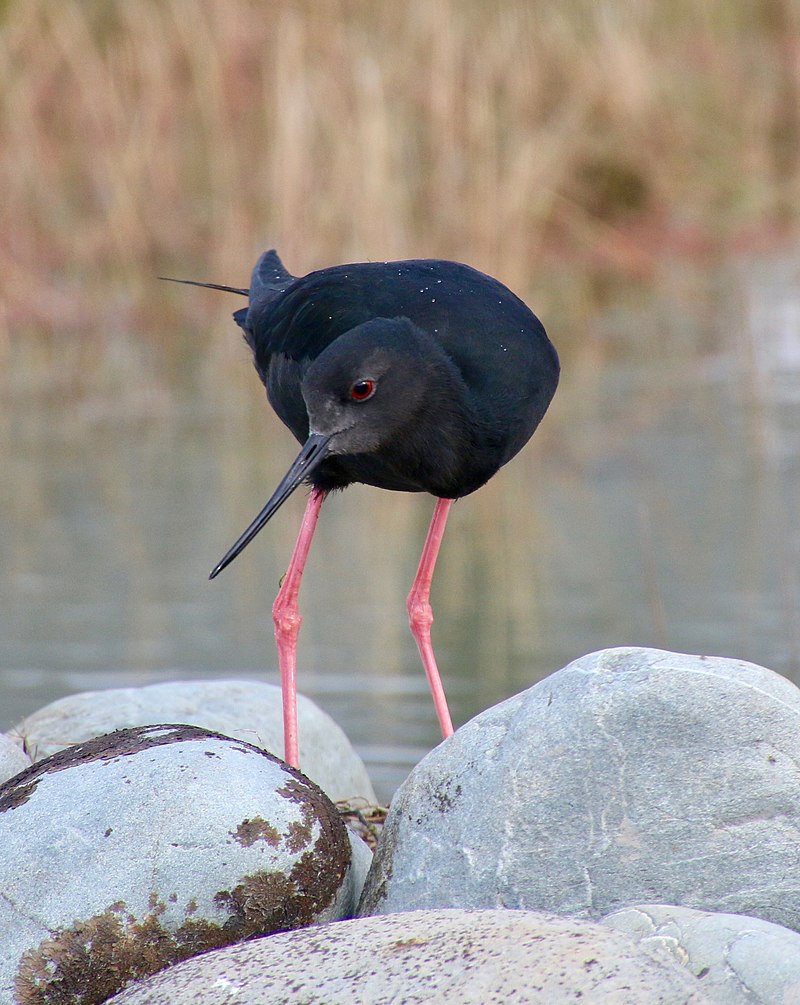
The Black stilt (Himantopus novaezelandiae) is a critically endangered wading bird found only in New Zealand. With an adult population of just 169, it is one of the world’s rarest birds.
It has distinctive black plumage and long pink legs, as well as a thin black bill that helps it to forage food from shallow waters.
The Black Stilt primarily breeds in the Mackenzie Basin located within South Island where they face threats caused by introduced feral cats, ferrets and hedgehogs which prey on their eggs and chicks.
Conservation efforts are ongoing with this species being intensively managed through predator control programs aimed at preserving its future existence in New Zealand’s wild places.Scientific classification:
| Kingdom | Animalia |
| Phylum | Chordata |
| Class | Aves |
| Order | Charadriiformes |
| Family | Recurvirostridae |
| Genus | Himantopus |
| Species | H. novaezelandiae |
26. Whitehead
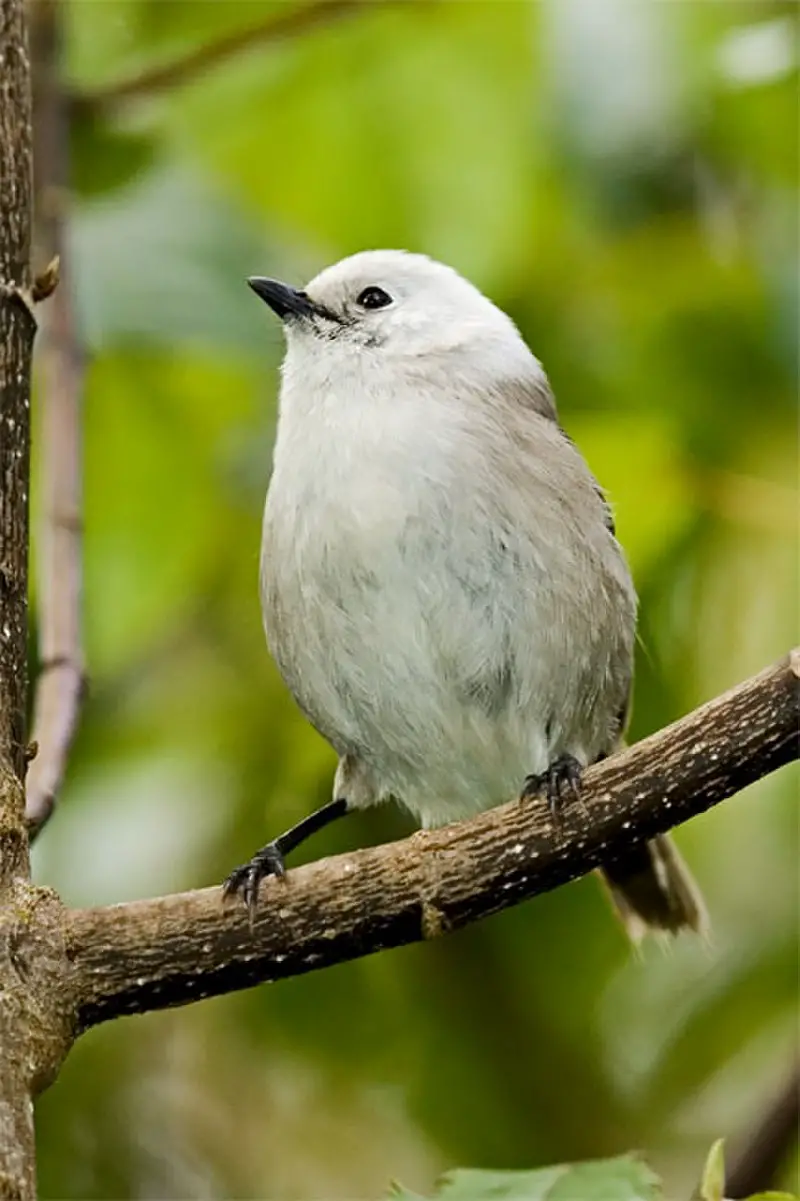
The Whitehead is an adorable little passerine bird native to New Zealand. It measures around 15 cm in length and weighs 18.5/14.5 g, making it one of the smallest birds found there.
The male has distinctive white head and underparts which contrast with its pale brown upperparts, wings and tail.
Females are similar but slightly duller whereas juveniles have a streaked pattern on their plumage instead of being pure white like males do.
They inhabit forests where they feed mainly on insects as well as berries when available during winter months while also drinking nectar from flowers occasionally too.Scientific classification:
| Kingdom | Animalia |
| Phylum | Chordata |
| Class | Aves |
| Order | Passeriformes |
| Family | Mohouidae |
| Genus | Mohoua |
| Species | M. albicilla |
27. Brown Teal
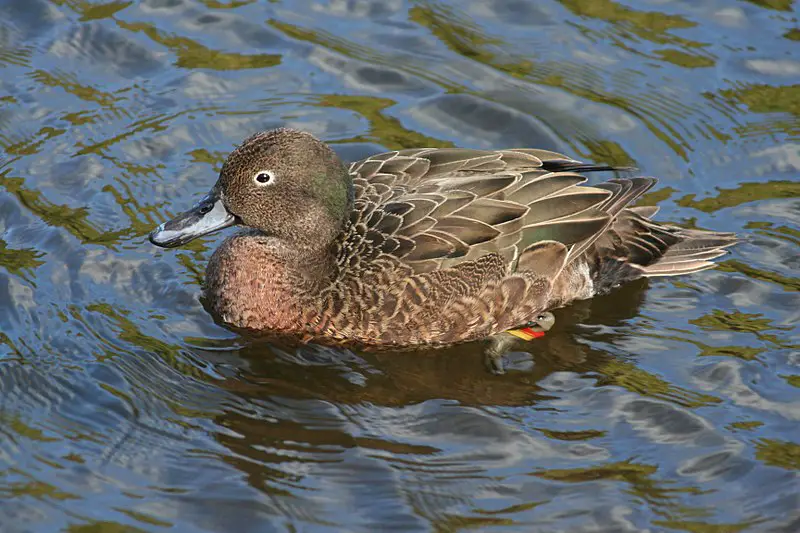
The Brown Teal is a species of dabbling duck native to New Zealand. It was long considered to be the same as Auckland and Campbell Teals, but has since been identified as its own species.
Once common in early European colonization times, it went through a severe decline due to human activities such as hunting and land clearance for agriculture.
Nowadays the population continues increasing thanks to conservation efforts like habitat protection, predator control, re-introduction programs and education campaigns about this beautiful bird’s plight.
The Brown Teal is an important part of New Zealand’s ecology thus making it worth protecting so our future generations can enjoy them too.Scientific classification:
| Kingdom | Animalia |
| Phylum | Chordata |
| Class | Aves |
| Order | Anseriformes |
| Family | Anatidae |
| Genus | Anas |
| Species | A. chlorotis |
28. Black-Billed Gull
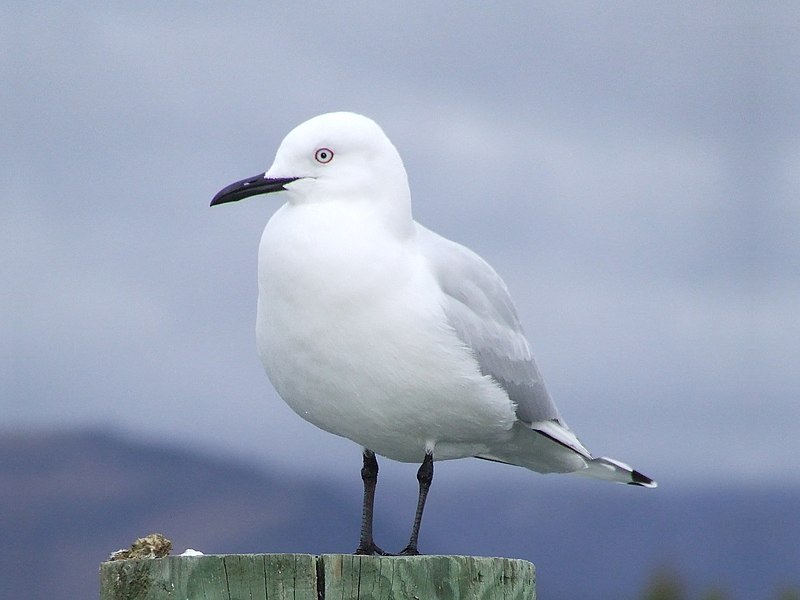
The Black-billed Gull, or Buller’s Gull, is a species of seabird found only in New Zealand. It has been classified as Near Threatened by the International Union for Conservation of Nature and Natural Resources due to its small population size.
The gulls evolved from their ancestors who migrated from Australia around 250 000 years ago. Initially named “Gavia pomare” by Carl Friedrich Bruch in 1855, Sir Walter Lawry Buller renamed it Chroicocephalus bulleri after himself.
This medium-sized seabird has black legs and feet with greenish yellow eyes that contrast against its predominantly brown plumage.
During breeding season they can be seen gathering on rocky islands near coasts throughout New Zealand where they nest amongst vegetation made up mostly of tussock grasses.Scientific classification:
| Kingdom | Animalia |
| Phylum | Chordata |
| Class | Aves |
| Order | Charadriiformes |
| Family | Laridae |
| Genus | Chroicocephalus |
| Species | C. bulleri |
Also Featured In: Birds That Live around Gull Rock,
29. Wrybill
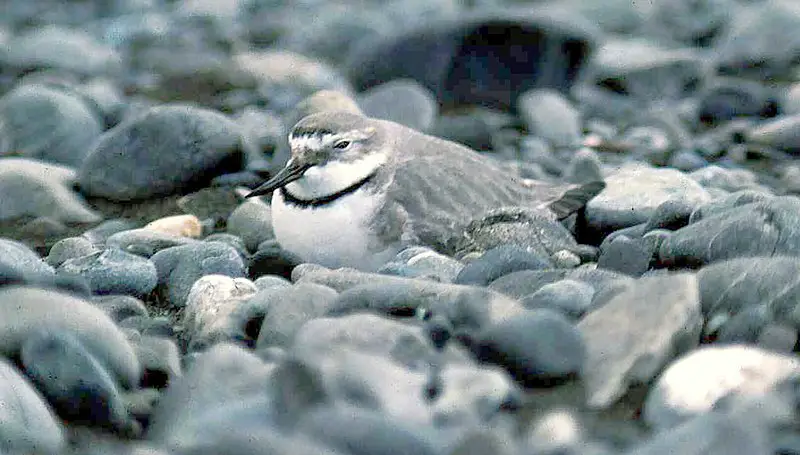
The Wrybill is a unique species of plover endemic to New Zealand. It’s the only bird in the world with its beak bent sideways – always to the right. The upper and lower mandibles are distinctively curved, giving it an unusual appearance.
Its scientific name Anarhynchus frontalis comes from Greek words meaning ‘without’ (an-) and ‘bend’ (-rhycgos) signifying this special trait.
In Māori it is called Ngutuparore which means “curved bill” or “bent beak”. These birds feed mainly on insects living near water bodies like rivers, streams, ponds etc., but also eat seeds when available.
They lay their eggs during spring-summer season in grassy nests close to water sources as protection from predators such as cats and hedgehogs.
As with most shorebirds they’re vulnerable creatures due to human activities that destroy their habitats so conservation efforts must continue for them survive into future generations.Scientific classification:
| Kingdom | Animalia |
| Phylum | Chordata |
| Class | Aves |
| Order | Charadriiformes |
| Family | Charadriidae |
| Genus | Anarhynchus |
| Species | A. frontalis |
30. Paradise Shelduck
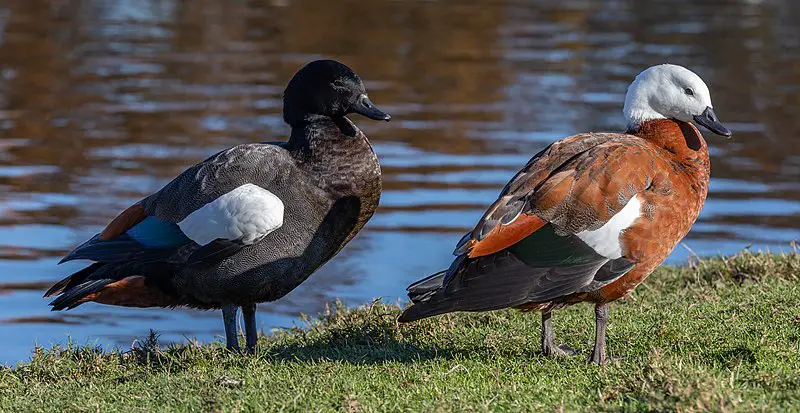
The Paradise Shelduck is an iconic bird native to New Zealand. It has a striking plumage, with the male having a black head and barred body while the female sports a white head with brown stripes on her back and wings.
This species of shelduck can be seen in various habitats such as wetlands, grasslands, coastal areas and even urban parks.
They feed mainly on aquatic plants but also eat molluscs, insects larvae and small fish when available.
Their conservation status is ‘not threatened’ due to their wide range throughout New Zealand which makes them one of our most visible waterfowls.Scientific classification:
| Kingdom | Animalia |
| Phylum | Chordata |
| Class | Aves |
| Order | Anseriformes |
| Family | Anatidae |
| Genus | Tadorna |
| Species | T. variegata |
31. New Zealand Rock Wren
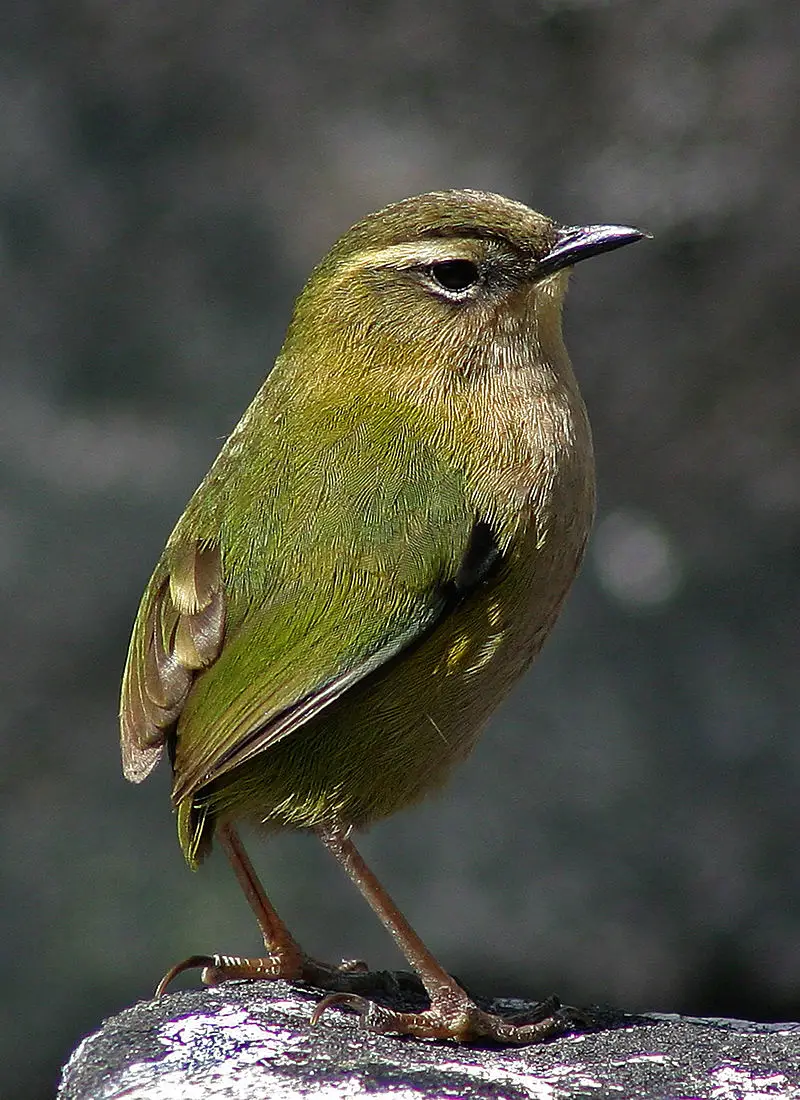
The New Zealand rock wren is a small bird, endemic to the South Island of New Zealand. It has many Māori names such as pīwauwau, mātuitui and tuke due to its distinct bobbing motion which resembles twitches or complaints.
This species of wren belongs to the Acanthisittidae family and outside NZ it is commonly referred to as rockwren in order differentiate itself from the North American version.
The plumage coloration varies between sexes with males having more greyish brown tones than females who are often darker overall but still retain some lighter patches throughout their body feathers.
These birds prefer inhabiting rocky terrain where they build intricate nests amongst crevices on cliff edges or boulder piles providing good protection against most predators both avian and mammalian alike.
The diet consists mainly of insects, fruit & berries although nocturnal foraging trips can be made into nearby vegetation when food supplies become scarce during winter monthsScientific classification:
| Kingdom | Animalia |
| Phylum | Chordata |
| Class | Aves |
| Order | Passeriformes |
| Family | Acanthisittidae |
| Genus | Xenicus |
| Species | X. gilviventris |
32. Shorebirds
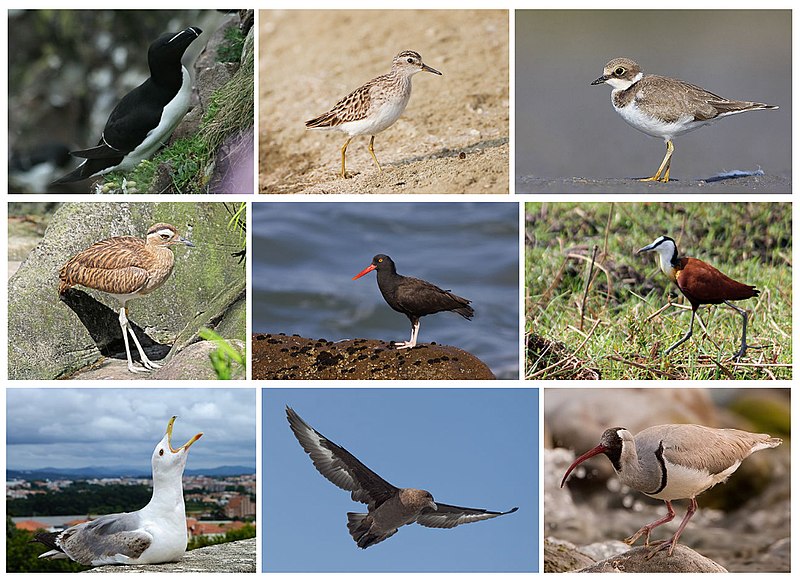
Shorebirds, a diverse group of birds in the Charadriiformes order, are found near water on every continent except Antarctica.
These small to medium-sized birds feed mainly on invertebrates and other small animals but can also be pelagic seabirds or inhabit deserts.
Shorebirds use their long bills to probe mudflats for food like worms and mollusks while some species plunge into the ocean’s depths in search of crustaceans such as crabs and shrimp.
They have strong legs equipped with webbed feet which allow them to move quickly when searching for prey across wetlands, sandbars, beaches and swamps.
Their feathers make them well adapted to life by land or sea due to its hydrophobic nature which helps reduce drag during swimming or flying through windy conditions making it easier for shorebirds survive tough environments around the world.Scientific classification:
| Kingdom | Animalia |
| Phylum | Chordata |
| Class | Aves |
| Infraclass | Neognathae |
| Clade | Neoaves |
| Clade | Gruimorphae |
| Order | Charadriiformes Huxley, 1867 |
33. Rail
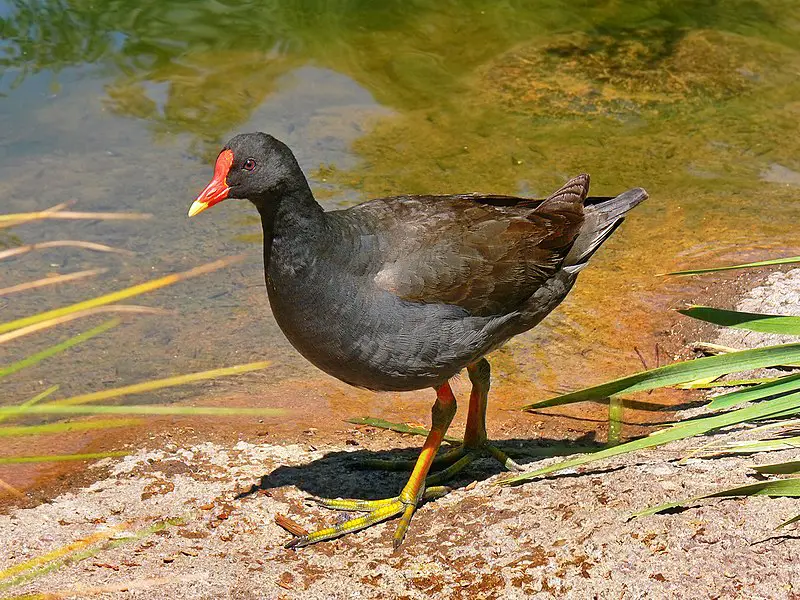
Rails are a diverse family of birds, ranging from small to medium size and living in habitats across the world.
They can be found around wetlands, as well as any other land-based environment except for dry deserts, polar regions or areas with persistent snow cover.
These ground-dwellers have short legs and long toes that help them maneuver through wetland vegetation easily.
Tey typically feed on insects and aquatic invertebrates but will also eat seeds and berries when available.
Species such as coots, crakes and gallinules have evolved different bill shapes to allow them to navigate their environments more efficiently while searching for food.
Rails live both alone or in pairs depending on the species; some migrate seasonally while others remain at one location year round.Scientific classification:
| Kingdom | Animalia |
| Phylum | Chordata |
| Class | Aves |
| Order | Gruiformes |
| Family | Rallidae Rafinesque, 1815 |
34. Australasian Swamphen
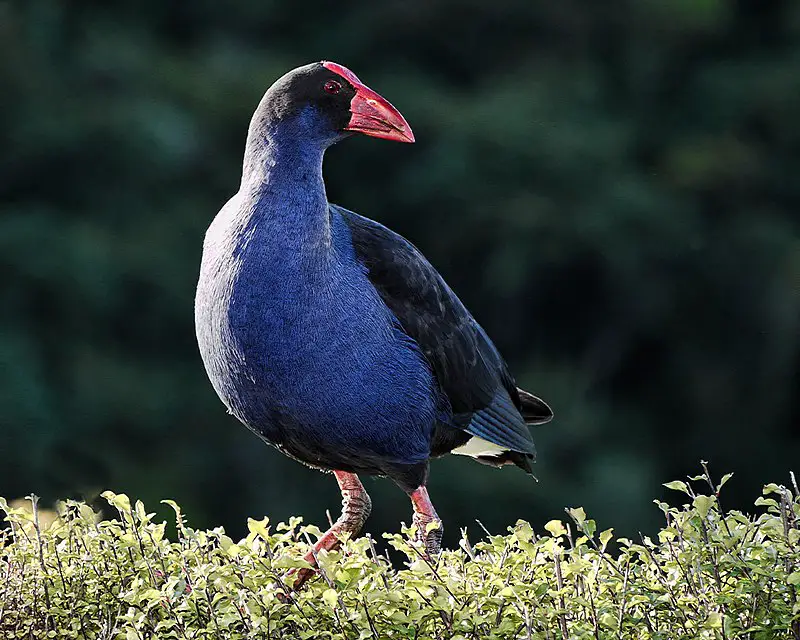
The Australasian swamphen is a species of waterbird found in eastern Indonesia, Papua New Guinea, Australia and New Zealand. In its native lands it’s known as the pukeko by Māori speakers.
It was once thought to be part of the purple swamphen subspecies but has since been classified as distinct from that particular species.
This bird prefers wetland habitats with still or slow-moving waters such as swamps and marshes where they feed on aquatic vegetation like grasses, sedges and rushes while also feasting upon small invertebrates when available.
The males are territorial during breeding season while their chicks will remain near parents until they become independent after two months old.
They’re overall excellent fliers which gives them an advantage against predators looking for easy meals.Scientific classification:
| Kingdom | Animalia |
| Phylum | Chordata |
| Class | Aves |
| Order | Gruiformes |
| Family | Rallidae |
| Genus | Porphyrio |
| Species | P. melanotus |
Also Featured In: Queensland Birds You Should Know,
35. Black-Fronted Tern
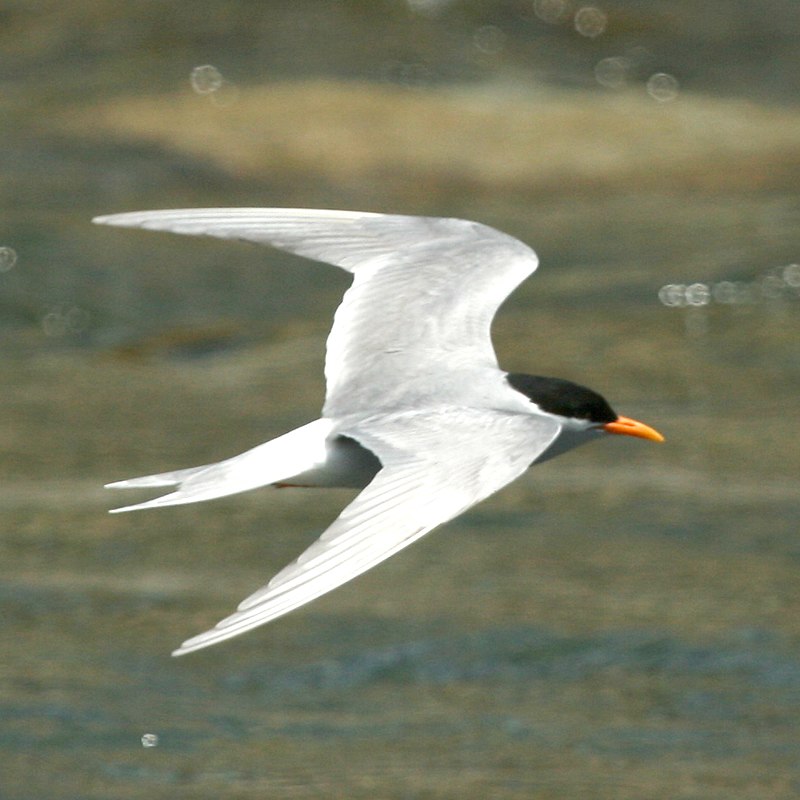
The Black-fronted Tern is a small species of tern found mainly in New Zealand. It has a mostly grey plumage and feeds on freshwater fish, arthropods and worms.
This bird breeds primarily in the eastern regions of the South Island, with its population having declined due to habitat loss over recent years.
The Black-fronted Tern prefers lowland sites near waterbodies such as rivers or lakes for nesting purposes, though it also occurs around coastal areas during migration periods.
Its call is high pitched and distinctive – one that can easily be recognized by experienced birdwatchers. Conservation efforts are underway to protect this unique species from further decline into extinction.Scientific classification:
| Kingdom | Animalia |
| Phylum | Chordata |
| Class | Aves |
| Order | Charadriiformes |
| Family | Laridae |
| Genus | Chlidonias |
| Species | C. albostriatus |
36. Black Robin
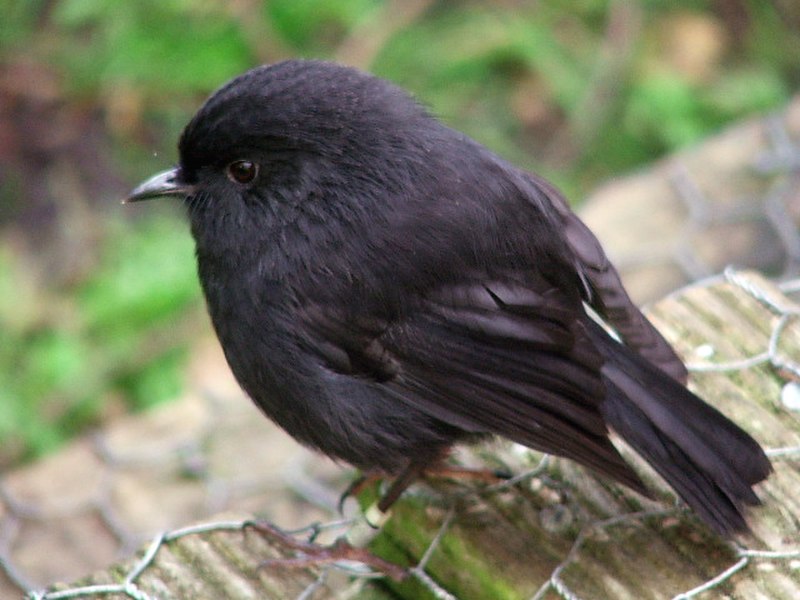
The Black robin is an endangered bird native to the Chatham Islands, a group of islands off the east coast of New Zealand. It was first described by Walter Buller in 1872 and its scientific name commemorates Henry H. Travers, a botanist from New Zealand
It is closely related to South Island Robin but has distinct features like brownish-black plumage with white patches on wings and tail feathers as well as a rufous breast colouration.
The female black robins have slightly duller colour than males along with darker heads while juveniles appear mainly greyish-brown overall having some mottled whitish markings over their body.
Despite being critically endangered due to predations, population decline and habitat destruction since 19th century.
Conservation efforts are helping them survive these days where they can be seen mostly during spring season when male birds sing loudly for attaining mates or establish territories which helps us make informed decisions regarding their future management plans for further protection measures in near future.Scientific classification:
| Kingdom | Animalia |
| Phylum | Chordata |
| Class | Aves |
| Order | Passeriformes |
| Family | Petroicidae |
| Genus | Petroica |
| Species | P. traversi |
37. Magenta Petrel
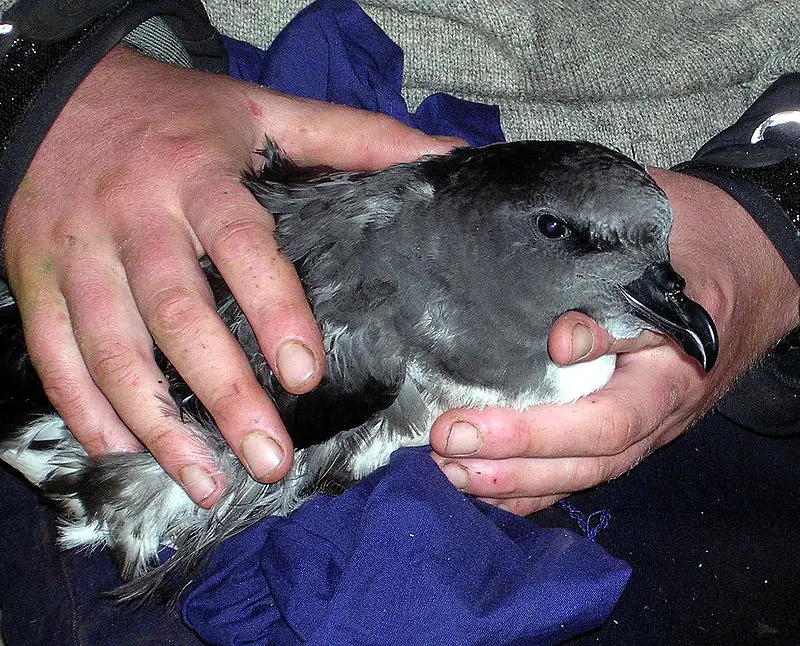
The magenta petrel is a rare and endangered species of seabird found exclusively on Chatham Island, New Zealand.
It has an unmistakable plumage with a brownish-grey head, neck and upper breast while the underparts are white.
This medium-sized petrel was believed to be extinct for over 100 years until its rediscovery in the 1970s when conservation efforts began to help protect it from extinction.
The bird’s diet consists mainly of small fish caught by surface feeding or midwater plunging dives at night when they also perform their courtship flights and display aerial singing behaviour.
For many years now local communities have been working hard towards protecting this special species which remains one of the world’s rarest birds todayScientific classification:
| Kingdom | Animalia |
| Phylum | Chordata |
| Class | Aves |
| Order | Procellariiformes |
| Family | Procellariidae |
| Genus | Pterodroma |
| Species | P. magentae |
Also Featured In: Welcome Islands Birds You Need To Know,
38. Chatham Petrel
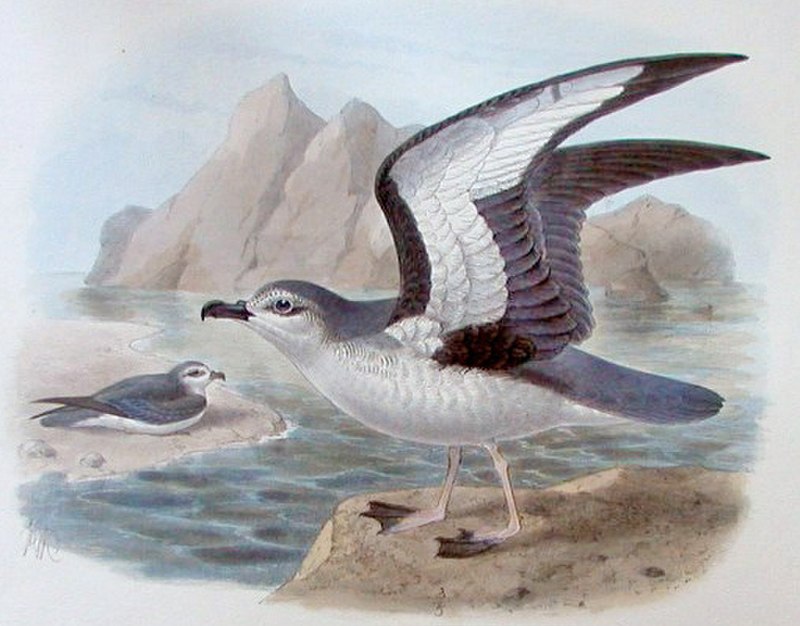
The Chatham Petrel is a unique bird found only on the Chatham Islands, New Zealand. It has a mottled dark-grey and white forehead with grey back and upper wings, and white underparts.
This petrel species prefers to nest in colonies limited to 218 hectares of Rangatira or South-East Island where it feeds mainly at sea but also forages over land for invertebrates such as grasshoppers.
The birds have adapted well to their environment by developing strong feet which allow them to walk on rough terrain when searching for food during breeding season.
They are highly social animals that travel great distances across the ocean looking for food sources while remaining faithful partners throughout life.
Their devotion makes them an ideal mascot of loyalty, resilience and courage.Scientific classification:
| Kingdom | Animalia |
| Phylum | Chordata |
| Class | Aves |
| Order | Procellariiformes |
| Family | Procellariidae |
| Genus | Pterodroma |
| Species | P. axillaris |
39. Cook’s Petrel
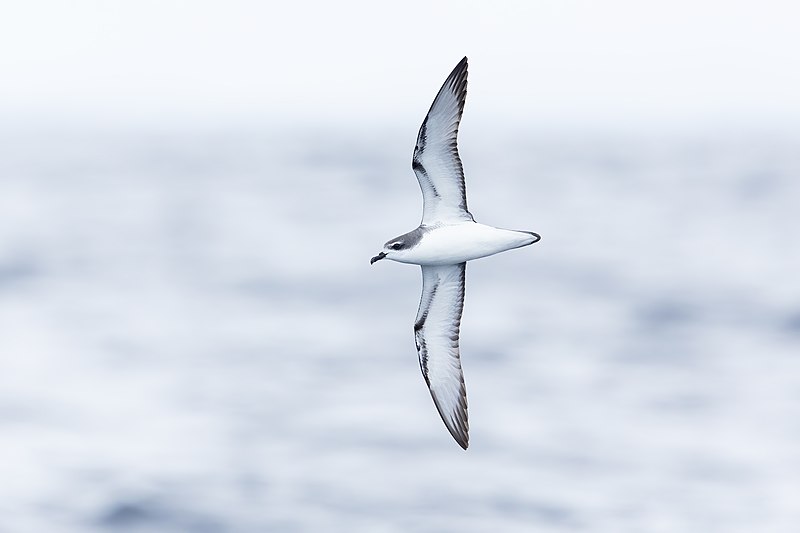
Cook’s petrel is a Procellariform seabird, belonging to the gadfly petrels and part of the Cookilaria subgroup.
It stands out amongst its peers due to its small size; typically 25-30 cm long with a wingspan of 65-66 cm and weighing approximately 200 g.
Its plumage is predominantly dark grey in colour which contrasts sharply against its bright blue feet – earning it another name: ‘blue footed petrel’.
Despite being one of the smallest species within this group, Cook’s Petrel can travel vast distances over open ocean waters using an advanced navigation system that helps them find food sources located thousands of kilometres away from their nesting grounds.Scientific classification:
| Kingdom | Animalia |
| Phylum | Chordata |
| Class | Aves |
| Order | Procellariiformes |
| Family | Procellariidae |
| Genus | Pterodroma |
| Species | P. cookii |
Also Featured In: Birds You’ll Find in the Marshall Islands,
40. New Zealand Parrot
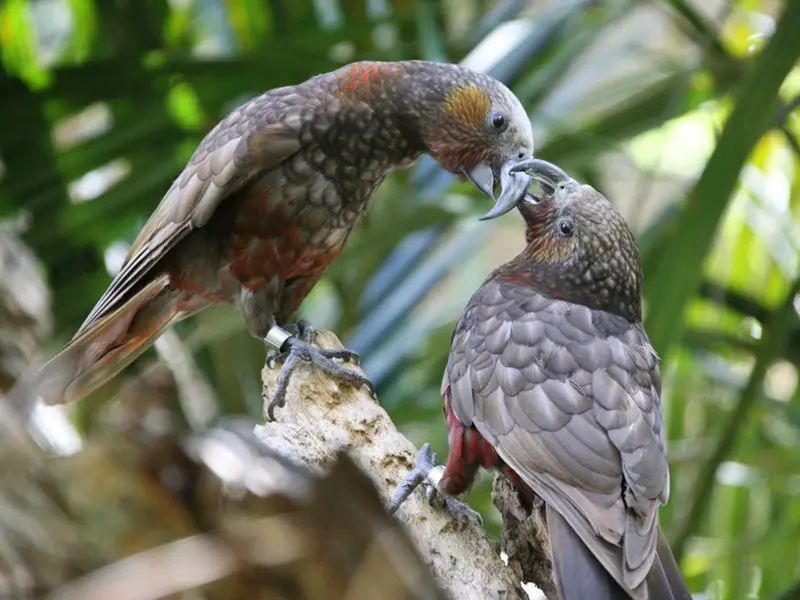
New Zealand parrot birds are a unique species of bird that can only be found in New Zealand.
They belong to the family Strigopidae and consist of several genera, including Nestor (which includes keas, kākās, Norfolk Kākās and Chatham Kākās) and Strigops (containing the iconic kakapo).
These species are all endemic to NZ meaning they cannot be found anywhere else on earth. Their brightly coloured feathers make them instantly recognisable amongst other birds as well as their characteristic calls.
The Nelepsittacus genus is extinct but may have included Heracles which is also most likely an extinct member from this group too.Scientific classification:
| Kingdom | Animalia |
| Phylum | Chordata |
| Class | Aves |
| Order | Psittaciformes |
| Superfamily | Strigopoidea Bonaparte, 1849 |
| Family | Strigopidae Bonaparte, 1849 |
41. South Island Kōkako
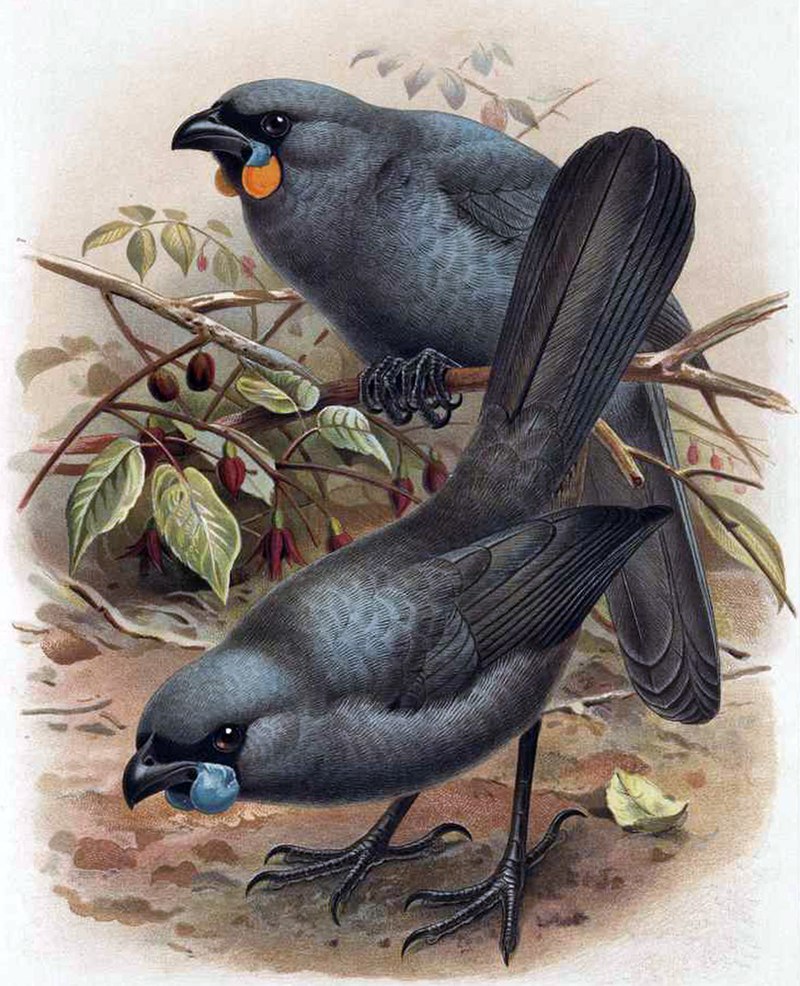
The South Island kōkako (Callaeas cinereus) is a species of forest bird endemic to the South Island of New Zealand.
It is closely related to, but distinct from its North Island counterpart with largely orange wattles and only a small patch of blue at the base; hence it was also known as an ‘orange-wattled crow’, though not part of the corvid family.
Regrettably, this beautiful native bird has been considered possibly extinct since 2007 when no sightings have been confirmed – making it one more victim in a long line of avian extinctions due to human interference.
Conservation efforts will hopefully help protect remaining populations so that we can continue enjoying these majestic birds for generations to come.Scientific classification:
| Kingdom | Animalia |
| Phylum | Chordata |
| Class | Aves |
| Order | Passeriformes |
| Family | Callaeidae |
| Genus | Callaeas |
| Species | C. cinerea |
42. Auckland Teal
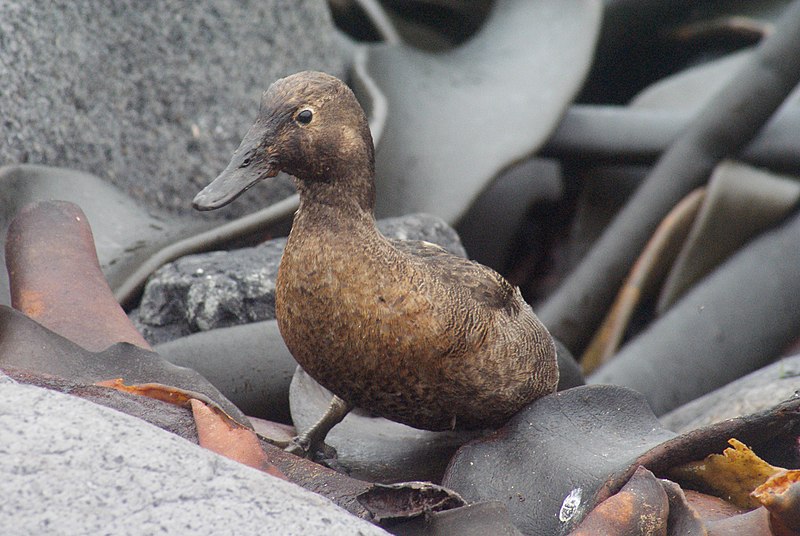
The Auckland teal is a species of dabbling duck, belonging to the genus Anas and endemic to the Auckland Islands south of New Zealand.
This small brown bird was once abundant in these islands but has become restricted due to the presence of introduced predators.
It can now only be found on Adams Island, Enderby Island, Disappointment Island and some smaller nearby islands which are still predator-free.
The males have dark heads with white stripes above their eyes while females are slightly lighter overall with more mottled wings and tail feathers than males.
Both sexes feed mainly on plant material such as seeds from grasses or sedges along shorelines or wetlands near rivers or lakes.
They also eat insects for protein during breeding season when raising young chicks that hatch out within 28 days after incubation begins.Scientific classification:
| Kingdom | Animalia |
| Phylum | Chordata |
| Class | Aves |
| Order | Anseriformes |
| Family | Anatidae |
| Genus | Anas |
| Species | A. aucklandica |
43. Kōkako
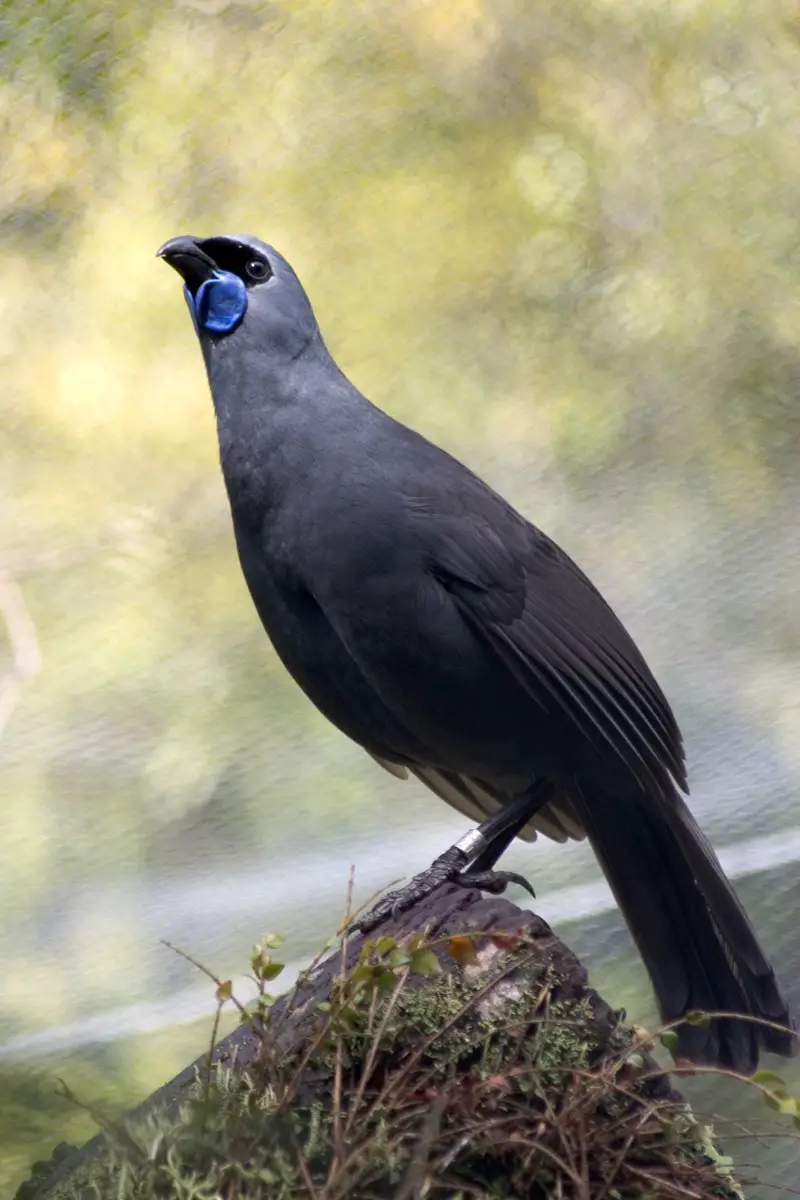
Kōkako are an endangered species of forest birds endemic to New Zealand. They have a slate-grey colouring, with black masks and wattles which give them their distinctive look.
The North Island Kōkako is the only surviving member of its genus; all other species – including the South Island kōkako – are believed to be extinct.
However, conservation efforts are being made in order to protect this beautiful bird from further loss.
It can often be found amongst native forests, where it feeds on fruits and invertebrates as part of its diet.
Its haunting call has been described by some as one of nature’s most graceful sounds – making it even more important that we do our best to preserve these precious creatures for future generations.Scientific classification:
| Kingdom | Animalia |
| Phylum | Chordata |
| Class | Aves |
| Order | Passeriformes |
| Family | Callaeidae |
| Genus | Callaeas J.R. Forster, 1788 |
44. Landfowl
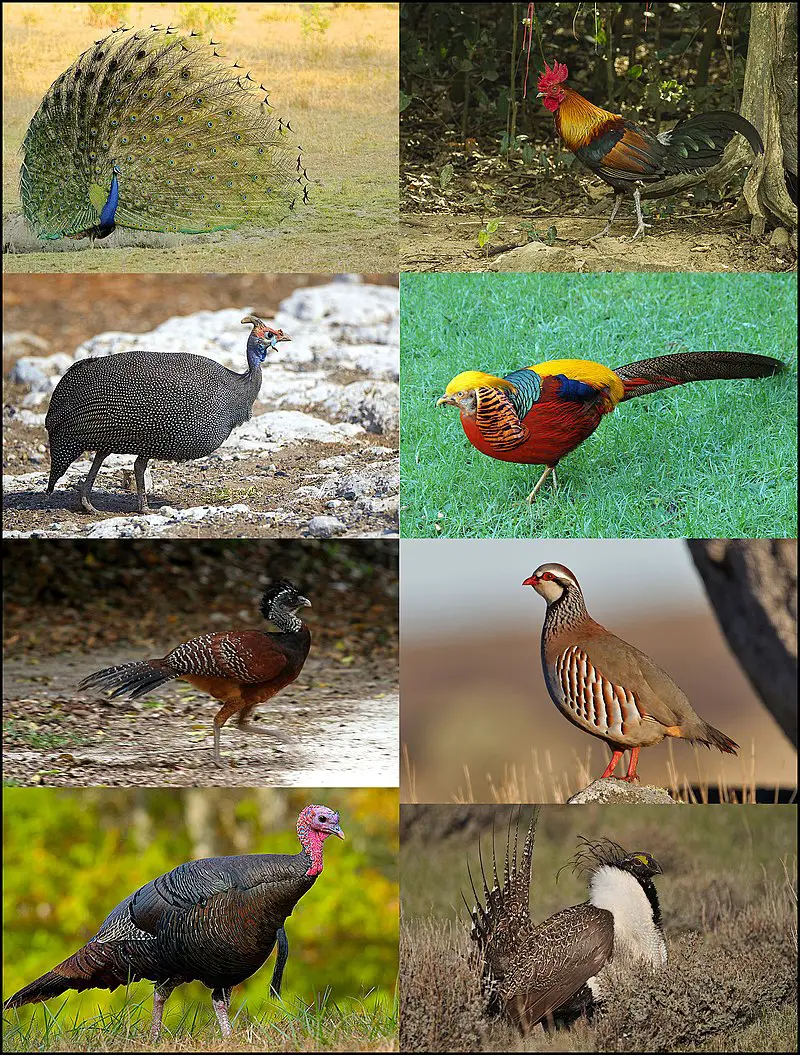
Landfowl birds belong to the Galliformes order, which includes turkeys, chickens, quail, and other ground-feeding species. These birds are essential in their environments as seed dispersers and predators.
Humans have found various uses for them such as raising them for meat or egg production or hunting them down for sports purposes. Landfowl inhabit almost all continents worldwide except Antarctica.
With around 290 different species of landfowl recorded so far, they come in a variety of shapes and sizes ranging from small quails to large gamebirds like turkey vultures.
Their diet consists mainly of plant seeds but they also supplement it with bugs and worms depending on availability within their habitat range.
To protect these beneficial creatures people should take care not to overhunt or destroy their living habitats as this can result in drastic population declines that may ultimately lead to extinction if no action is taken soon enough.Scientific classification:
| Kingdom | Animalia |
| Phylum | Chordata |
| Class | Aves |
| Clade | Pangalliformes |
| Order | Galliformes Temminck, 1820 |
45. Oystercatchers
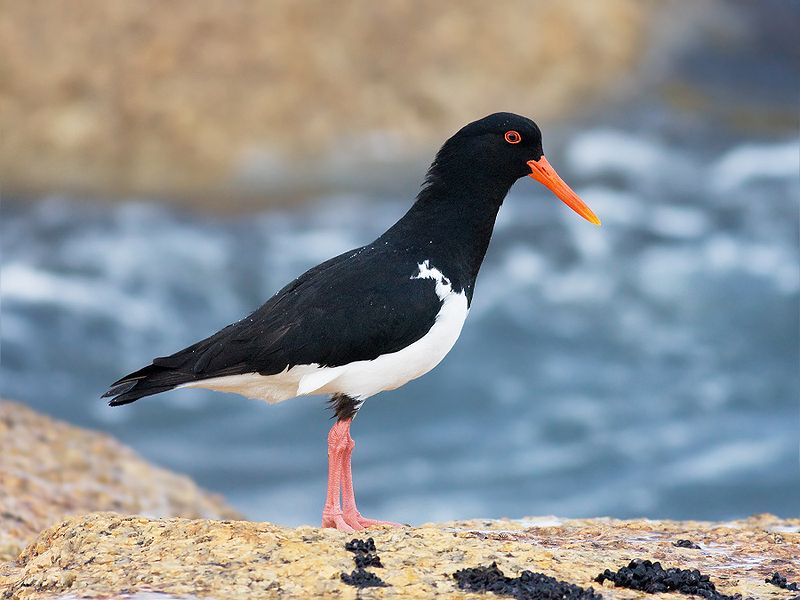
Oystercatchers are a family of waders forming the Haematopodidae, with one genus; Haematopus.
They live in coastal regions around the world excluding both polar and some tropical areas of Africa & South East Asia.
Eurasian, South Island & Magellanic oystercatcher species also breed far inland – breeding grounds being found much deeper than other members of the family.
They have long beaks used to feed on molluscs such as mussels, clams and oysters which they crack open using their strong bills.
Oystercatchers are usually quite vocal birds making various loud calls when disturbed or alarmed.
The males tend to display more brightly coloured plumage compared to females who share similar brown/black hues for camouflage purposes during nesting season.Scientific classification:
| Kingdom | Animalia |
| Phylum | Chordata |
| Class | Aves |
| Order | Charadriiformes |
| Suborder | Charadrii |
| Family | Haematopodidae Bonaparte, 1838 |
| Genus | Haematopus Linnaeus, 1758 |
46. Cape Barren Goose
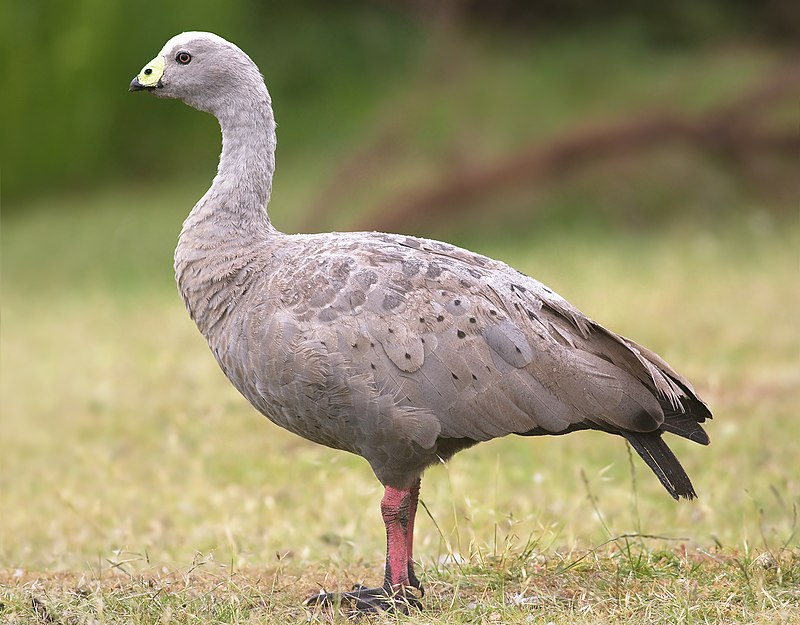
The Cape Barren goose is a large species of bird native to southern Australia. Its name derives from the Cape Barren Island, where it was first sighted by European explorers in 1801.
This goose belongs to the Jardwadjali language and is known as toolka there. It has an eye-catching plumage with greyish-brown feathers on its body and wings, while its head appears black or brownish.
The neck sports white stripes which look like arrowheads when seen up close, adding beauty to this majestic looking creature.
They feed mainly on grasses but also consume other vegetation such as seaweed and eelgrass during their migration season in summertime.
These geese are gregarious birds that live together in flocks for protection against predators.
To conclude, these magnificent creatures can be found all across southern Australian regions – making them truly one of nature’s wonders.Scientific classification:
| Kingdom | Animalia |
| Phylum | Chordata |
| Class | Aves |
| Order | Anseriformes |
| Family | Anatidae |
| Subfamily | Anserinae |
| Genus | Cereopsis Latham, 1801 |
| Species | C. novaehollandiae |
Also Featured In: Common Melbourne Birds, South Australian Birds
47. Common Wood Pigeon
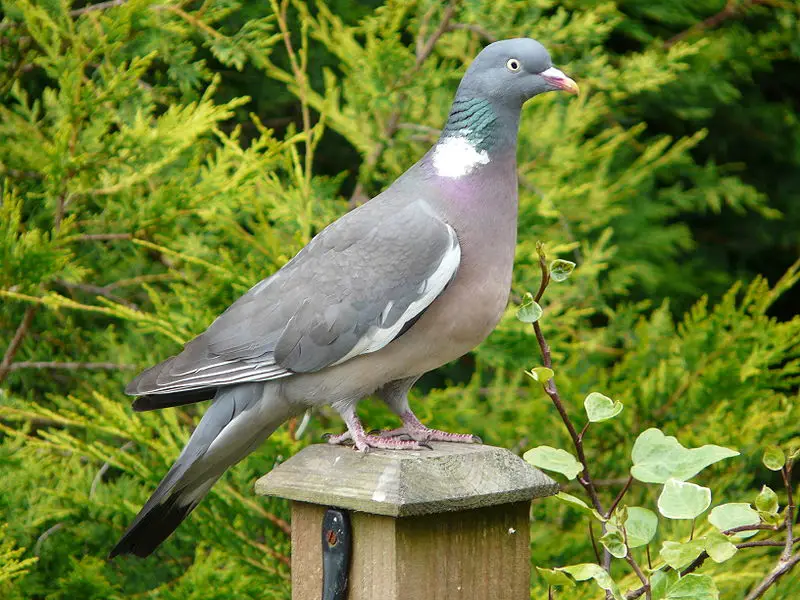
The Common Wood Pigeon is a large bird of the dove and pigeon family, native to the western Palearctic. It has grey plumage with white patches on its wings and neck.
Its head often appears darker than its body due to iridescence in some parts of its feathers. The male woodpigeons have pinkish breasts while females are more brownish-grey coloured.
These birds feed mainly on seeds, fruits, flowers and leaves but will also eat insects when available.
They breed during springtime producing 1-2 clutches per breeding season with two eggs each time which hatch after about 18 days incubation period by both parents taking turns for duty.
They make their nests from twigs collected from nearby trees or places close by and usually raise only one brood at a time making them an important part of nature’s balance as they help keep insect populations under control through their diet choices.Scientific classification:
| Kingdom | Animalia |
| Phylum | Chordata |
| Class | Aves |
| Order | Columbiformes |
| Family | Columbidae |
| Genus | Columba |
| Species | C. palumbus |
48. Antarctic Petrel
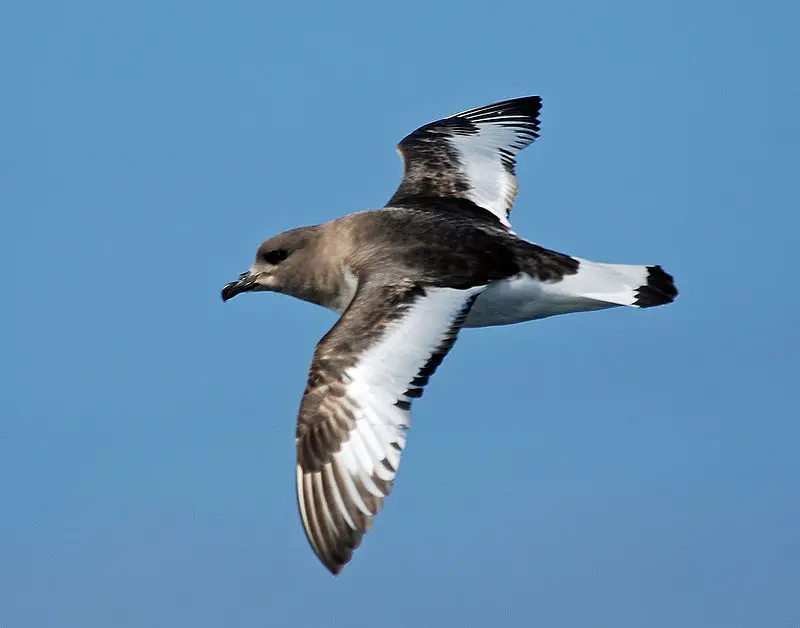
The Antarctic petrel is a dark brown and white boldly marked petrel, found mainly in the Ross and Weddell Seas of Antarctica.
It feeds on krill, fish, and small squid while swimming but can also dive from both the surface or air.
The bird was first seen by Captain James Cook during his second voyage to the south Pacific in 1773.
These birds have strong wings which allow them to stay aloft for long periods of time whilst searching for food over vast distances.
They are incredibly social creatures that travel together in large flocks when not breeding season; however they become very territorial when it comes to nesting sites where they will fiercely defend their territory against any intruders.Scientific classification:
| Kingdom | Animalia |
| Phylum | Chordata |
| Class | Aves |
| Order | Procellariiformes |
| Family | Procellariidae |
| Genus | Thalassoica Reichenbach, 1853 |
| Species | T. antarctica |
Also Featured In: South Shetland Islands Birds You Need To Know,